Infrastructure Elements for Smart Campuses: A Bibliometric Analysis
Abstract
:1. Introduction
2. Materials and Methods
2.1. Data Collection
2.2. Data Analysis and Visualisation
3. Results: Overview of Smart Campus Research
3.1. Trend in Smart Campus Research
3.2. Discussion of Smart Campus Infrastructure Themes
3.2.1. Categorising Smart Campus Infrastructure
3.2.2. Auto-Analysers
3.2.3. Energy Management System (EMS)
3.2.4. Cloud Computing
3.2.5. Smart City
3.2.6. Education Management System
3.2.7. Smart Campus Network Grid
3.2.8. Internet of Things (IoTs) and Smart Buildings
3.2.9. Inclusive Smart Technology
3.2.10. Performance Measurement and Forecasting
3.2.11. Smart Campus Applications
3.2.12. Learning Management System
3.2.13. Data Mining
3.2.14. Campus Information Portal
3.2.15. Deep Learning Architecture
3.2.16. Campus Equipment Management Service (CEMS)
4. Implications of Findings
4.1. Framework Conceptualisation
4.2. Implications of Findings on Procurement of Smart Campus Infrastructure
4.2.1. Implications on Smart Campus Building Construction or Repurposing
4.2.2. Implications on Technology and IT Network in a Smart Campus
4.2.3. Implications on Continuous Improvement of Smart Campus Infrastructure
4.2.4. Implications on Smart Learning and Teaching Systems
4.3. Implication of Findings for Future Research
- Application of BIM in delivering smart campuses
- IT project management in smart campus procurement
- Investigations into the best procurement strategies for smart campuses
- Contractual arrangement in smart campus procurement.
5. Conclusions and Limitations of the Study
Supplementary Materials
Author Contributions
Funding
Institutional Review Board Statement
Data Availability Statement
Acknowledgments
Conflicts of Interest
References
- Min-Allah, N.; Alrashed, S. Smart campus—A sketch. Sustain. Cities Soc. 2020, 59, 102231. [Google Scholar] [CrossRef]
- Chen, Y.; Zhang, R. The Construction and Trend of Intelligent Information Campus. In Proceedings of the 13th International Conference on Enterprise Information Systems, Beijing, China, 8–11 June 2011; SciTePress—Science and and Technology Publications: Beijing, China, 2011. [Google Scholar] [CrossRef]
- Awuzie, B.; Ngowi, A.B.; Omotayo, T.; Obi, L.; Akotia, J. Facilitating successful smart campus transitions: A systems thinking-SWOT analysis approach. Appl. Sci. 2021, 11, 2044. [Google Scholar] [CrossRef]
- Wang, F.; Jia, Z.-S. Constructing Digital Campus Using Campus Smart Card System. In Advances in Intelligent and Soft Computing; Springer: Berlin/Heidelberg, Germany, 2012; pp. 19–26. [Google Scholar] [CrossRef]
- Verstaevel, N.; Boes, J.; Gleizes, M.-P. From Smart Campus to Smart Cities: Issues of the Smart Revolution. Available online: https://hal.archives-ouvertes.fr/hal-01873804/document (accessed on 6 July 2021).
- Huang, Z. An analysis of information security and protection strategies in colleges and universities in the environment of smart campuses. J. Phys. Conf. Ser. 2021, 1852, 042050. [Google Scholar] [CrossRef]
- Ma, N.; Fu, W. Analysis of cloud computing algorithm based on smart campus message system. Int. J. Perform. Eng. 2019, 15, 700. [Google Scholar] [CrossRef]
- Du, S.; Meng, F.; Gao, B. Research on the application system of smart campus in the context of smart city. In Proceedings of the 2016 8th International Conference on Information Technology in Medicine and Education (ITME), Fuzhou, China, 23–25 December 2016. [Google Scholar]
- Huang, C. On study of building smart campus under conditions of cloud computing and internet of things. IOP Conf. Ser. Earth Environ. Sci. 2017, 100, 012118. [Google Scholar] [CrossRef] [Green Version]
- Zhicheng, D.; Feng, L. Evaluation of the Smart Campus Information Portal. In Proceedings of the 2018 2nd International Conference on Education and E-Learning, Bali, Indonesia, 5–7 November 2018; ACM: New York, NY, USA, 2018. [Google Scholar] [CrossRef]
- Tang, R.H.; Tang, Y.R.; Dong, J. The Design and Application of “Cloud-Edge-End” Integrated Computation in the Higher Education Teaching Informatization Construction. In Proceedings of the 2020 4th International Conference on Management Engineering, Software Engineering and Service Sciences, Wuhan, China, 17–19 January 2020; ACM: New York, NY, USA, 2020. [Google Scholar]
- Liu, H.; Zhu, Y.; Zang, T.; Yu, J.; Cai, H. Jointly Modeling Individual Student Behaviors and Social Influence for Prediction Tasks. In Proceedings of the 29th ACM International Conference on Information & Knowledge Management, Online, 19–23 October 2020; ACM: New York, NY, USA, 2020. [Google Scholar]
- Geng, L. Research on the design of teaching service app based on user experience—Taking “i Sino-Korea” as an example. In Proceedings of the 2017 12th International Conference on Computer Science and Education (ICCSE), Houston, TX, USA, 22–25 August 2017. [Google Scholar]
- Abd, A.M.; Hameed, A.H.; Nsaif, B.M. Documentation of construction project using integration of BIM and GIS technique. Asian J. Civ. Eng. 2020, 21, 1249–1257. [Google Scholar] [CrossRef]
- Li, M. Based on the construction of financial management information platform of colleges and universities in 5G environment—Take guangzhou nanyang polytechnic vocational college as an example. J. Phys. Conf. Ser. 2020, 1616, 012011. [Google Scholar] [CrossRef]
- Nan, F.; Suo, Y.; Jia, X.; Wu, Y.; Shan, S. Real-time monitoring of smart campus and construction of weibo public opinion platform. IEEE Access 2018, 6, 76502–76515. [Google Scholar] [CrossRef]
- Rong, J. Research on intelligent campus construction based on virtual reality technology. In Proceedings of the 2020 International Conference on Computer Vision, Image and Deep Learning (CVIDL), Nanchang, China, 15–17 May 2020. [Google Scholar]
- Pérez-Acebo, H.; Linares-Unamunzaga, A.; Abejón, R.; Rojí, E. Research trends in pavement management during the first years of the 21st century: A bibliometric analysis during the 2000–2013 period. Appl. Sci. 2018, 8, 1041. [Google Scholar] [CrossRef] [Green Version]
- Zyoud, S.H.; Waring, W.S.; Al-Jabi, S.W.; Sweileh, W.M. Global cocaine intoxication research trends during 1975–2015: A bibliometric analysis of web of science publications. Subst. Abus. Treat. Prev. Policy 2017, 12, 6. [Google Scholar] [CrossRef] [Green Version]
- Zhai, Z.; Shan, M.; Darko, A.; Chan, A.P.C. Corruption in construction projects: Bibliometric analysis of global research. Sustainability 2021, 13, 4400. [Google Scholar] [CrossRef]
- Hosseini, M.R.; Martek, I.; Zavadskas, E.K.; Aibinu, A.A.; Arashpour, M.; Chileshe, N. Critical evaluation of off-site construction research: A scientometric analysis. Autom. Constr. 2018, 87, 235–247. [Google Scholar] [CrossRef]
- Elsevier. Content Coverage Guide. 2010. Available online: https://www.elsevier.com/__data/assets/pdf_file/0017/114533/Scopus_GlobalResearch_Factsheet2019_FINAL_WEB.pdf (accessed on 6 July 2021).
- Wang, H.; Chen, Q.; Hong, A.; Wang, X.; Hou, Z.; Cheng, L. The hotspots of smart education in China: Base on the bibliometric analysis and knowledge mapping. IOP Conf. Ser. Mater. Sci. Eng. 2020, 806, 012016. [Google Scholar] [CrossRef]
- Bastidas-Manzano, A.B.; Sánchez-Fernández, J.; Casado-Aranda, L.A. The past, present, and future of smart tourism destinations: A bibliometric analysis. J. Hosp. Tour. Res. 2021, 45, 529–552. [Google Scholar] [CrossRef]
- Rochat, Y. Closeness Centrality Extended to Unconnected Graphs: The Harmonic Centrality Index; University of Lausanne: Lausanne, Switzerland, 2009. [Google Scholar]
- Thangaraj, M.; Amutha, S. Mgephi: Modified gephi for effective social network analysis. Int. J. Sci. Res. Comput. Sci. Eng. Inf. Technol. 2018, 1, 39–50. [Google Scholar]
- Grandjean, M. Gephi: Introduction to Network Analysis and Visualization. 2015. Available online: http://www.martingrandjean.ch/gephi-introduction/ (accessed on 5 June 2021).
- Abejón, R.; Pérez-Acebo, H.; Clavijo, L. Alternatives for chemical and biochemical lignin valorization: Hot topics from a bibliometric analysis of the research published during the 2000–2016 period. Processes 2018, 6, 98. [Google Scholar] [CrossRef] [Green Version]
- Chen, H.; Jiang, W.; Yang, Y.; Yang, Y.; Man, X. State of the art on food waste research: A bibliometrics study from 1997 to 2014. J. Clean. Prod. 2017, 140, 840–846. [Google Scholar] [CrossRef]
- Qi, X.W.; Hao, Z.P. Design of smart wireless campus network based on zigbee. Appl. Mech. Mater. 2014, 687–691, 1864–1867. [Google Scholar] [CrossRef]
- Wan, L.; Deng, Z.H. Research on the construction of smarter campus system based on mobile phone M2M. Appl. Mech. Mater. 2014, 635–637, 1806–1810. [Google Scholar] [CrossRef]
- Wang, H.I. Constructing the green campus within the internet of things architecture. Int. J. Distrib. Sens. Netw. 2014, 10, 804627. [Google Scholar] [CrossRef] [Green Version]
- Zhang, W. Research and Practice of Cloud Desktop Teaching System. In Advances in Intelligent Systems and Computing; Springer International Publishing: Cham, Switzerland, 2020; pp. 638–642. [Google Scholar] [CrossRef]
- Feng, P. Construction of Smart Campus under the Background of Big Data. In Application of Intelligent Systems in Multi-Modal Information Analytics; Springer International Publishing: Cham, Switzerland, 2021; pp. 32–36. [Google Scholar]
- Putman, K.; Boekhout, H.D.; Takes, F.W. Fast Incremental Computation of Harmonic Closeness Centrality in Directed Weighted Networks. In Proceedings of the 2019 IEEE/ACM International Conference on Advances in Social Networks Analysis and Mining, Vancouver, BC, Canada, 27–30 August 2019; ACM: New York, NY, USA, 2019. [Google Scholar] [CrossRef]
- Althobaiti, M.M.; Technology, I.; Arabia, S. Toward a smart campus based on smart technologies and best. Build. Res. Inf. 2020, 49, 1–20. [Google Scholar]
- Wang, J.; Yu, X.; Zeng, Y.; Yang, D. The Design and Realization of Campus Information Release Platform Based on Android Framework. In Communications in Computer and Information Science; Springer: Berlin/Heidelberg, Germany, 2013; pp. 121–128. [Google Scholar] [CrossRef]
- Feng, P. Construction of Intelligent Campus Information under the Background of Big Data. In Advances in Intelligent Systems and Computing; Springer International Publishing: Cham, Switzerland, 2021; pp. 1012–1017. [Google Scholar]
- Qian, T.; Zhang, Q. Research on Teaching Management of Applied University Based on Big Data. In Advances in Intelligent Systems and Computing; Springer International Publishing: Cham, Switzerland, 2021; pp. 666–674. [Google Scholar] [CrossRef]
- Xiao, F.; Haigen, Y.; Qian, D.; Yusheng, H.; Hongyan, Y.; Wenting, X.; Jun, M.; Feng, G. Research and design of digital library based on virtual reality. In Proceedings of the 2019 IEEE 4th International Conference on Image, Vision and Computing (ICIVC), Xiamen, China, 5–7 July 2019. [Google Scholar]
- Rosado, L.; Hagy, S.; Kalmykova, Y.; Morrison, G.; Ostermeyer, Y. A living lab co-creation environment exemplifying factor 10 improvements in a city district. J. Urban Regen. Renew. 2015, 8, 171–185. [Google Scholar]
- Zhan, H.; Liu, Z.; Lu, F.; Ma, X.; Zhang, S.; Chen, Y. A Construction Framework Design of Smart Classroom in Universities Based on Pedagogy-Space-Technology Framework. In Innovative Computing; Lecture Notes in Electrical Engineering; Springer: Singapore, 2020; pp. 1647–1654. [Google Scholar]
- Kaplan, D. The Bellwether—A Passive House Tower Renews a Public Housing Campus. 50 Forward 50 Back: The Recent History and Essential Future of Sustainable Cities. Available online: https://global.ctbuh.org/resources/papers/download/4284-the-bellwethera-passive-house-tower-renews-a-public-housing-campus.pdf (accessed on 5 June 2021).
- Zhou, Z.; Yu, H.; Shi, H. Optimization of wireless video surveillance system for smart campus based on internet of things. IEEE Access 2020, 8, 136434–136448. [Google Scholar] [CrossRef]
- Mostafa, S.A.; Mustapha, A.; Ramli, A.A.; Jubair, M.A.; Hassan, M.H.; Abbas, A.H. Comparative Analysis to the Performance of Three Mobile Ad-Hoc Network Routing Protocols in Time-Critical Events of Search and Rescue Missions. In Advances in Simulation and Digital Human Modeling; Springer International Publishing: Cham, Switzerland, 2021; pp. 117–123. [Google Scholar]
- Pasetti, M.; Sisinni, E.; Ferrari, P.; Rinaldi, S.; Depari, A.; Bellagente, P.; Della Giustina, D.; Flammini, A. Evaluation of the use of class B LoRaWAN for the coordination of distributed interface protection systems in smart grids. J. Sens. Actuator Netw. 2020, 9, 13. [Google Scholar] [CrossRef] [Green Version]
- Chen, K.; He, J. Big-Data-Based Research on the Architecture Design of University Hydropower Intelligent Decision Service Platform. In Proceedings of the 2021 9th International Conference on Communications and Broadband Networking, Shanghai, China, 25–27 February 2021; ACM: New York, NY, USA, 2021. [Google Scholar] [CrossRef]
- Hou, D. Exploration and Practice of the Joint Operation Model of Campus Network in Border Universities. In Application of Intelligent Systems in Multi-modal Information Analytics; Springer International Publishing: Cham, Switzerland, 2021; pp. 715–722. [Google Scholar] [CrossRef]
- Zhen, Z. Research and Design of Big Data Unified Analysis Platform Based on Cloud Computing. In Application of Intelligent Systems in Multi-Modal Information Analytics; Springer International Publishing: Cham, Switzerland, 2021; pp. 908–913. [Google Scholar] [CrossRef]
- Formhals, J.; Feike, F.; Hemmatabady, H.; Welsch, B.; Sass, I. Strategies for a transition towards a solar district heating grid with integrated seasonal geothermal energy storage. Energy 2021, 228, 120662. [Google Scholar] [CrossRef]
- He, X.; Zhang, W. Research on the Application Status of University Sports Big Data. In Proceedings of the 2021 2nd International Conference on Computers, Information Processing and Advanced Education, Ottawa, ON, Canada, 25–27 May 2021; ACM: New York, NY, USA, 2021. [Google Scholar] [CrossRef]
- Wu, B.; Wang, Y.; Liu, R.; Tan, S.; Hao, R. Research of intelligent campus design based on immersive bim + vr technology. J. Phys. Conf. Ser. 2021, 1885, 052053. [Google Scholar] [CrossRef]
- Wu, B.; Hao, R.; Li, H.; Chai, Q.; Wang, Y. Research on intelligent campus system design based on BIM & VR/AR technology. J. Phys. Conf. Ser. 2021, 1885, 052050. [Google Scholar] [CrossRef]
- Pingrong, L.; Xiaoquan, S.; Junqin, Y. Research on the application of DevOps in the smart campus of colleges and universities. J. Phys. Conf. Ser. 2021, 1883, 012101. [Google Scholar] [CrossRef]
- Li, Y. Application of big data technology in campus security management under the background of information age. J. Phys. Conf. Ser. 2021, 1881, 022097. [Google Scholar] [CrossRef]
- Li, G.; Zheng, C.; Han, D.; Li, M. Research on smart campus architecture based on the six domain model of the internet of things. J. Phys. Conf. Ser. 2021, 1861, 012038. [Google Scholar] [CrossRef]
- Guofeng, X.; Mingzhu, L. The application of big data technology in the construction of smart campus in vocational colleges. J. Phys. Conf. Ser. 2021, 1827, 012134. [Google Scholar] [CrossRef]
- Crisis, J.S.; Van Els, R.H. Design of a Smart Microgrid Laboratory Platform for University Campus. In Transdisciplinary Engineering: Crossing Boundaries; Borsato, M., Ed.; IOS Press: Amsterdam, The Netherlands, 2016; pp. 206–215. [Google Scholar] [CrossRef]
- Mazza, I.F.S. Strategic Management of Resources and Technologies for a Smart and Green Space Campus. In Proceedings of the International Astronautical Congress, Jerusalem, Israel, 12–16 October 2015; pp. 9476–9480. [Google Scholar]
- Michailidis, I.T.; Schild, T.; Sangi, R.; Michailidis, P.; Korkas, C.; Fütterer, J.; Müller, D.; Kosmatopoulos, E.B. Energy-efficient HVAC management using cooperative, self-trained, control agents: A real-life german building case study. Appl. Energy 2018, 211, 113–125. [Google Scholar] [CrossRef]
- Kiefer, C.P.; Carrillo-Hermosilla, J.; Del Río, P.; Barroso, F.J.C. Diversity of eco-innovations: A quantitative approach. J. Clean. Prod. 2017, 166, 1494–1506. [Google Scholar] [CrossRef]
- Karabetça, A.R. Resilient materials and structures emulating natural organisms. In Proceedings of the 3rd International Conference on New Trends in Architecture and Interior Design, Helsinki, Finland, 28–30 April 2017. [Google Scholar]
- Cao, J.; Li, Z.; Luo, Q.; Hao, Q.; Jiang, T. Research on the construction of smart university campus based on big data and cloud computing. In Proceedings of the 2018 International Conference on Engineering Simulation and Intelligent Control (ESAIC), Changsha, China, 10–11 August 2018. [Google Scholar]
- Tang, Z. On study of application of big data and cloud computing technology in smart campus. IOP Conf. Ser. Earth Environ. Sci. 2017, 100, 012026. [Google Scholar] [CrossRef] [Green Version]
- Liu, Y.L.; Zhang, W.H.; Dong, P. Research on the construction of smart campus based on the internet of things and cloud computing. Appl. Mech. Mater. 2014, 543–547, 3213–3217. [Google Scholar] [CrossRef]
- Yang, C.T.; Chen, S.T.; Liu, J.C.; Liu, R.H.; Chang, C.L. On construction of an energy monitoring service using big data technology for the smart campus. Clust. Comput. 2020, 23, 265–288. [Google Scholar] [CrossRef]
- Fangguo, W. Design of teaching model of ideological and political education network course based on educational cloud platform. In Proceedings of the 2020 5th International Conference on Smart Grid and Electrical Automation (ICSGEA), Zhangjiajie, China, 13–14 June 2020. [Google Scholar]
- Reddy, S.K.; Pal, P.K. Detection of traversable region around a mobile robot by computing terrain unevenness from the range data of a 3D laser scanner. Int. J. Intell. Unmanned Syst. 2016, 4, 107–128. [Google Scholar] [CrossRef]
- Nielsen, E.S. Smart Growth Machines: The Ecological Modernization of Urban Political Economy. In From Sustainable to Resilient Cities: Global Concerns and Urban Efforts (Research in Urban Sociology, Vol. 14); Emerald Group Publishing Limited: Bingley, UK, 2014; pp. 169–190. [Google Scholar] [CrossRef]
- Slavova, M.; Okwechime, E. African smart cities strategies for agenda 2063. Afr. J. Manag. 2016, 2, 210–229. [Google Scholar] [CrossRef]
- Toutouh, J.; Arellano, J.; Alba, E. BiPred: A bilevel evolutionary algorithm for prediction in smart mobility. Sensors 2018, 18, 4123. [Google Scholar] [CrossRef] [PubMed] [Green Version]
- Shen, Q.; Wang, H.; Tang, B.-S. A decision-making framework for sustainable land use in Hong Kong’s urban renewal projects. Smart Sustain. Built Environ. 2014, 3, 35–53. [Google Scholar] [CrossRef]
- Cacho, A.; Mendes-Filho, L.; Estaregue, D.; Moura, B.; Cacho, N.; Lopes, F.; Alves, C. Mobile tourist guide supporting a smart city initiative: A brazilian case study. Int. J. Tour. Cities 2016, 2, 164–183. [Google Scholar] [CrossRef]
- Advanced Material Research. In Proceedings of the 2nd International Conference on Smart City and Systems Engineering, Changsha, China, 11–12 November 2017; Available online: https://searchworks.stanford.edu/view/13498238 (accessed on 5 June 2021).
- Sidawi, B.; Deakin, M. Diabetes, built environments and (Un) healthy lifestyles: The potential of smart city technologies. Smart Sustain. Built Environ. 2013, 2, 311–323. [Google Scholar] [CrossRef]
- Bifulco, F.; Tregua, M.; Amitrano, C.C.; D’Auria, A. ICT and sustainability in smart cities management. Int. J. Public Sect. Manag. 2016, 29, 132–147. [Google Scholar] [CrossRef]
- Wang, M.; Liu, Y. Wisdom city under the perspective of intelligent factors of the brand of meta-analysis in colleges and universities to explore. J. Phys. Conf. Ser. 2020, 1533, 032079. [Google Scholar] [CrossRef]
- Capdevila, I.; Zarlenga, M.I. Smart city or smart citizens? The barcelona case. J. Strat. Manag. 2015, 8, 266–282. [Google Scholar] [CrossRef]
- Scuotto, V.; Ferraris, A.; Bresciani, S. Internet of things: Applications and challenges in smart cities: A case study of IBM smart city projects. Bus. Process Manag. J. 2016, 22. [Google Scholar] [CrossRef]
- Nyberg, R.A.; Yarime, M. Assembling a Field into Place: Smart-City Development in Japan. In Emergence (Research in the Sociology of Organisations, Vol. 50); Emerald Publishing Limited: Bingley, UK, 2017; pp. 253–279. [Google Scholar] [CrossRef]
- Girtelschmid, S.; Steinbauer, M.; Kumar, V.; Fensel, A.; Kotsis, G. On the application of big data in future large-scale intelligent smart city installations. Int. J. Pervasive Comput. Commun. 2014, 10, 168–182. [Google Scholar] [CrossRef]
- Riezebos, J.; Huisman, B. Value stream mapping in education: Addressing work stress. Int. J. Qual. Reliab. Manag. 2020, 38, 1044–1061. [Google Scholar] [CrossRef]
- Ying, H. Study on the key algorithms and framework design of intelligent campus education platform based on big data technology. Bol. Tec. Tech. Bull. 2017, 55, 63–69. [Google Scholar]
- Li, Y.Y.; Chen, H.H.; Shao, W.C.; Jing, S.R.; Chiu, F.Y.; Su, H.J. Practices of innovative technology and education for sustainability in Taiwan sustainable campus program. In Proceedings of the 2017 Pacific Neighborhood Consortium Annual Conference and Joint Meetings (PNC), Taiwan, China, 7–9 November 2017. [Google Scholar]
- Molderez, I.; Ceulemans, K. The power of art to foster systems thinking, one of the key competencies of education for sustainable development. J. Clean. Prod. 2018, 186, 758–770. [Google Scholar] [CrossRef]
- Balzer, W.K.; Brodke, M.H.; Kizhakethalackal, E.T. Lean higher education: Successes, challenges, and realizing potential. Int. J. Qual. Reliab. Manag. 2015, 32, 924–933. [Google Scholar] [CrossRef]
- Zhang, W.; Jiang, L. Algorithm analysis for big data in education based on depth learning. Wirel. Pers. Commun. 2018, 102, 3111–3119. [Google Scholar] [CrossRef]
- Williams, A.; Kennedy, S.; Philipp, F.; Whiteman, G. Systems thinking: A review of sustainability management research. J. Clean. Prod. 2017, 148, 866–881. [Google Scholar] [CrossRef] [Green Version]
- Li, W. Design of smart campus management system based on internet of things technology. IEEE Access 2018, 6, 62601–62611. [Google Scholar] [CrossRef]
- Alkhammash, M.; Beloff, N.; White, M. An Internet of Things and Blockchain Based Smart Campus Architecture. In Advances in Intelligent Systems and Computing; Springer International Publishing: Cham, Switzerland, 2020; pp. 467–486. [Google Scholar] [CrossRef]
- Tang, H.; Chen, C. The construction of intelligent transportation system based on the construction of wisdom campus—Take soochow university as an example. In Proceedings of the 2016 Eighth International Conference on Measuring Technology and Mechatronics Automation (ICMTMA), Macau, China, 11–12 March 2016. [Google Scholar]
- Li, N.N.; Zhang, X.F.; Wang, Y.F.; Zhang, R. Design and implementation of campus dining application based on android. Appl. Mech. Mater. 2014, 556–562, 5250–5254. [Google Scholar] [CrossRef]
- Ebadi, N.; Kang, J.E.; Hasan, S. Constructing activity–mobility trajectories of college students based on smart card transaction data. Int. J. Transp. Sci. Technol. 2017, 6, 316–329. [Google Scholar] [CrossRef]
- Qianqiu, D. Exploration on the cultivation of college students’ leadership under the smart campus system. In Proceedings of the 2020 International Conference on Modern Education and Information Management (ICMEIM), Changsha, China, 18–20 September 2020. [Google Scholar]
- Betancur, M.J.; Restrepo, V.; Perez, J.J.; Restrepo, J.A.; Agudelo, A.; Cuartas-Ramirez, D. An approximation to the construction of pedestrian smart cities. In Proceedings of the 2019 IEEE 4th Colombian Conference on Automatic Control (CCAC), Medellin, Colombia, 15–18 October 2019. [Google Scholar]
- Chang, C.H.; Jiang, F.C.; Yang, C.T.; Chou, S.C. On construction of a big data warehouse accessing platform for campus power usages. J. Parallel Distrib. Comput. 2019, 133, 40–50. [Google Scholar] [CrossRef]
- Huang, Y.; Ali, S.; Bi, X.; Zhai, X.; Liu, R.; Guo, F.; Yu, P. Research on smart campus based on the internet of things and virtual reality. Int. J. Smart Home 2016, 10, 213–220. [Google Scholar] [CrossRef]
- Caranica, A.; Vulpe, A.; Fratu, O. Tenable Smart Building Security Flow Architecture Using Open Source Tools. In Advances in Intelligent Systems and Computing; Springer International Publishing: Cham, Switzerland, 2018; pp. 118–127. [Google Scholar]
- Xie, J.; Yang, Y. IoT-based model for intelligent innovation practice system in higher education institutions. J. Intell. Fuzzy Syst. 2021, 40, 2861–2870. [Google Scholar] [CrossRef]
- Fortino, G.; Russo, W.; Savaglio, C.; Shen, W.; Zhou, M. Agent-oriented cooperative smart objects: From iot system design to implementation. IEEE Trans. Syst. Man Cybern. Syst. 2018, 48, 1939–1956. [Google Scholar] [CrossRef]
- Vivi, Q.L.; Parlikad, A.K.; Woodall, P.; Ranasinghe, G.D.; Heaton, J. Developing a Dynamic Digital Twin at a Building Level: Using Cambridge Campus as Case Study. In Proceedings of the International Conference on Smart Infrastructure and Construction 2019 (ICSIC), Cambridge, UK, 8–10 July 2019; ICE Publishing: Cambridge, UK, 2019. [Google Scholar] [CrossRef] [Green Version]
- Zhang, L.; Yuan, H.; Chang, S.-H.; Lam, A. Research on the overall architecture of internet of things middleware for intelligent industrial parks. Int. J. Adv. Manuf. Technol. 2020, 107, 1081–1089. [Google Scholar] [CrossRef]
- Wang, L.; Li, K.; Chen, X. Internet of Things Security Analysis of Smart Campus. In Cloud Computing and Security; Springer International Publishing: Cham, Switzerland, 2018; pp. 418–428. [Google Scholar]
- Liu, B.; Du, Z. Advances in Services Science and Services Information Technology; WIT Press: Southampton, UK, 2014. [Google Scholar]
- Wang, Y.; Si, H.; Su, Y.; Xu, P. Advances in Applied Sciences and Manufacturing. In Proceedings of the 2013 International Forum on Materials Analysis and Testing Technology (IFMATT 2013), Qingdao, China, 9–10 December 2013; Collection of Selected, Peer Reviewed Papers. Available online: https://www.scientific.net/book/advances-in-applied-sciences-and-manufacturing/978-3-03826-334-0 (accessed on 6 July 2021).
- Haupt, T.C.; Pillay, K. Investigating the true costs of construction accidents. J. Eng. Des. Technol. 2016, 14, 373–419. [Google Scholar] [CrossRef]
- Pino, M.; Mortari, L. The inclusion of students with dyslexia in higher education: A systematic review using narrative synthesis: The inclusion of students with dyslexia in HE. Dyslexia 2014, 20, 346–369. [Google Scholar] [CrossRef] [PubMed] [Green Version]
- Ryder, D.T. Dyslexia Assessment Practice within the UK Higher Education Sector: Assessor, Lecturer and Student Perspectives. Ph.D. Thesis, University of Exeter, Exeter, UK, 2016. [Google Scholar] [CrossRef] [Green Version]
- Case Study: Supporting a Dyslexic Student. Available online: https://www.ed.ac.uk/student-disability-service/staff/supporting-students-key-information-for-staff/case-study-supporting-a-dyslexic-student (accessed on 6 July 2021).
- Bilau, A.B.; Ajagbe, A.S.; Kigbu, H.H.; Sholanke, A.B. Review of shortage of skilled craftsmen in small and medium construction firms in Nigeria. J. Environ. Earth Sci. 2015, 5, 98–111. [Google Scholar]
- Writing Skills. Dyslexia in Higher Education. Available online: http://crr.ugent.be/papers/Doctoraat_wim_tops.pdf (accessed on 6 July 2021).
- Zhang, X.; Sun, G.; Pan, Y.; Sun, H.; He, Y.; Tan, J. Students performance modeling based on behavior pattern. J. Ambient Intell. Humaniz. Comput. 2018, 9, 1659–1670. [Google Scholar] [CrossRef]
- Zhang, X.; Sun, G.; Pan, Y.; Sun, H.; Tan, J. Poor performance discovery of college students based on behavior pattern. In Proceedings of the 2017 IEEE SmartWorld, Ubiquitous Intelligence & Computing, Advanced & Trusted Computed, Scalable Computing & Communications, Cloud & Big Data Computing, Internet of People and Smart City Innovation (SmartWorld/SCALCOM/UIC/ATC/CBDCom/IOP/SCI), San Francisco, CA, USA, 4–8 August 2017. [Google Scholar]
- Xu, X.; Wang, Y.; Yu, S. Teaching performance evaluation in smart campus. IEEE Access 2018, 6, 77754–77766. [Google Scholar] [CrossRef]
- Bracco, S.; Delfino, F.; Pampararo, F.; Robba, M.; Rossi, M. Economic and environmental performances quantification of the university of genoa smart polygeneration microgrid. In Proceedings of the 2012 IEEE International Energy Conference and Exhibition (ENERGYCON), Florence, Italy, 9–12 September 2012. [Google Scholar]
- Zhai, X.; Dong, Y.; Yuan, J. Investigating learners’ technology engagement—A perspective from ubiquitous game-based learning in smart campus. IEEE Access 2018, 6, 10279–10287. [Google Scholar] [CrossRef]
- Kim, J.; Cheong, S.K. Research on an authentication algorithm for an electronic attendance system in the constructing of a smart campus. Int. J. Secur. Appl. 2013, 7, 199–208. [Google Scholar] [CrossRef]
- Gao, B.; Liu, F.; Du, S.; Meng, F. An OAuth2.0-Based Unified Authentication System for Secure Services in the Smart Campus Environment. In Proceedings of the International Conference on Computational Science, Wuxi, China, 11–13 June 2018; Lecture Notes in Computer Science. Springer International Publishing: Cham, Switzerland, 2018; pp. 752–764. [Google Scholar] [CrossRef]
- Liu, B.; Liu, R.; Lu, X.; Xie, Y.; Wang, X. Study of the virtual reality smart simulation campus based on vega. In Proceedings of the 2011 Second International Conference on Mechanic Automation and Control Engineering, Inner Mongolia, China, 15–17 July 2011. [Google Scholar]
- Sun, R.; Xi, J.; Yin, C.; Wang, J.; Kim, G.J. Location privacy protection research based on querying anonymous region construction for smart campus. Mob. Inf. Syst. 2018, 2018, 3682382. [Google Scholar] [CrossRef]
- Xing, C.J.; Yuan, L.; Yang, X.; Lai, T.-P.; Zhang, Z.-K. Research and practice on self-service terminal in smart campus. Tongxin Xuebao J. Commun. 2014, 35, 118–123. [Google Scholar] [CrossRef]
- Broujeny, R.S.; Madani, K.; Chebira, A.; Amarger, V.; Hurtard, L. Data-driven living spaces’ heating dynamics modeling in smart buildings using machine learning-based identification. Sensors 2020, 20, 1071. [Google Scholar] [CrossRef] [Green Version]
- Liu, D.; Huang, R.; Wosinski, M. Smart Learning in Digital Campus. In Smart Learning in Smart Cities; Lecture Notes in Educational Technology; Springer: Singapore, 2017; pp. 51–90. [Google Scholar]
- Qin, D.; Lin, W.; Xu, G.; Chen, X. Exploration of campus card management from the perspective of network security. Shenzhen Daxue Xuebao (Ligong Ban) J. Shenzhen Univ. Sci. Eng. 2020, 2020, 64–67. [Google Scholar] [CrossRef]
- Vivi, Q.L.; Parlikad, A.K.; Woodall, P.; Ranasinghe, G.D.; Heaton, J.; Li, G. Development of a virtual butterfly ecological system based on augmented reality and mobile learning technologies. Virtual Real. 2015, 19, 253–266. [Google Scholar] [CrossRef]
- Jiang, T.; Cao, J.; Su, D.; Yang, X. Analysis and data mining of students’ consumption behavior based on a campus card system. In Proceedings of the 2017 International Conference on Smart City and Systems Engineering (ICSCSE), Changsha, China, 11–12 November 2017. [Google Scholar]
- Wang, F.; Wang, F.; Hang, L. Research and implementation of campus card data analysis system. In Proceedings of the 13th International Conference on Enterprise Information Systems, Beijing, China, 8–11 June 2011; pp. 515–518. [Google Scholar]
- Chen, W.Z.Y. Data mining method for implicit user behavior in smart campus. Liaoning Gongcheng Jishu Daxue Xuebao (Ziran Kexue Ban) J. Liaoning Tech. Univ. (Nat. Sci. Ed.) 2020, 39, 434–439. [Google Scholar]
- Azad University of Quchan; National Institute of Technology Rourkela; University Polytechnic of Bucharest. Advanced Materials Research. In Proceedings of the 2013 International Conference on Mechatronics and Semiconductor Materials (ICMSCM 2013), Xi’an, China, 28–29 September 2013. [Google Scholar]
- Zhang, L.; Song, W. Research on Intrusion Detection Algorithm Based on Smart Campus Network Security. In Proceedings of the 2020 International Conference on Aviation Safety and Information Technology, Weihai, China, 14–16 October 2020; ACM: New York, NY, USA, 2020. [Google Scholar] [CrossRef]
- Li, Y. Research on building smart campus based on cloud computing technology. In Proceedings of the 2020 5th International Conference on Mechanical, Control and Computer Engineering (ICMCCE), Harbin, China, 25–27 December 2020. [Google Scholar]
- Zhang, Z.; Hu, G.; Wu, F.; Wang, C. The campus surveying control network digital construction planning and implementation. In Proceedings of the 2018 26th International Conference on Geoinformatics, Kunming, China, 28–30 June 2018. [Google Scholar]
- Cai, Z. Campus employment information network development based on android platform; big data and smart city. In Proceedings of the 2015 International Conference on Intelligent Transportation, Big Data and Smart City, Halong Bay, Vietnam, 19–20 December 2015; pp. 196–199. [Google Scholar] [CrossRef]
- Gupta, S.K.; Ashwin, T.S.; Guddeti, R.M.R. Students’ affective content analysis in smart classroom environment using deep learning techniques. Multimed. Tools Appl. 2019, 78, 25321–25348. [Google Scholar] [CrossRef]
- Chen, L.W.; Chen, T.P.; Chen, D.E.; Liu, J.X.; Tsai, M.F. Smart campus care and guiding with dedicated video footprinting through internet of things technologies. IEEE Access 2018, 6, 43956–43966. [Google Scholar] [CrossRef]
- Luo, L. Data acquisition and analysis of smart campus based on wireless sensor. Wirel. Pers. Commun. 2018, 102, 2897–2911. [Google Scholar] [CrossRef]
- Liang, W. Analysis of the application of artificial intelligence technology in the construction of smart campus. In Proceedings of the 2020 International Wireless Communications and Mobile Computing (IWCMC), Limassol, Cyprus, 15–19 June 2020. [Google Scholar]
- Zhou, X. Application research of face recognition technology in smart campus. J. Phys. Conf. Ser. 2020, 1437, 012130. [Google Scholar] [CrossRef]
- Moutinho, C.; Cunha, Á.; Caetano, E. Reducing Vibrations in a Footbridge Using a Semi-Active Tuned Mass Damper. In Proceedings of the 6th International Conference on Computational Methods in Structural Dynamics and Earthquake Engineering (COMPDYN 2015), Athens, Greece, 15–17 June 2017. [Google Scholar]
- Reddy, B.V.; Sahu, S.K.; Kandasamy, A.; de la Sen, M. (Eds.) Advanced Development in Industry and Applied Mechanics: Selected, Peer Reviewed Papers from the 3rd International Conference on Advances in Mechanics Engineering (ICAME 2014), July 28-29, Hong Kong, China; Trans Tech Publications: Zürich, Switzerland, 2014. [Google Scholar]
- Villegas-Ch, W.; Palacios-Pacheco, X.; Luján-Mora, S. Application of a smart city model to a traditional university campus with a big data architecture: A sustainable smart campus. Sustainability 2019, 11, 2857. [Google Scholar] [CrossRef] [Green Version]
- Banta, L.; Rossi, I.; Traverso, A.; Traverso, A.N. Advanced control of a real smart polygeneration microgrid. Energy Procedia 2014, 61, 274–277. [Google Scholar] [CrossRef] [Green Version]
- Mi, Z.; Cao, Z. Construction of the Computer Network Courses in College Physical Education Distance Video Teaching. In Advances in Intelligent Systems and Computing; Springer: Singapore, 2020; pp. 1567–1572. [Google Scholar]
- Omotayo, T.S.; Boateng, P.; Osobajo, O.; Oke, A.; Obi, L.I. Systems thinking and CMM for continuous improvement in the construction industry. Int. J. Product. Perform. Manag. 2019, 69, 271–296. [Google Scholar] [CrossRef]
- Omotayo, T.; Bankole, A.; Olanipekun, A.O. An artificial neural network approach to predicting most applicable post-contract cost controlling techniques in construction projects. Appl. Sci. 2020, 10, 5171. [Google Scholar] [CrossRef]
- Advanced Materials Research. In Proceedings of the 3rd International Conference on Energy, Environment and Sustainable Development (EESD 2013), Shanghai, China, 12–13 November 2013; Available online: https://hmongstudies.library.wisc.edu/catalog/HmongStudies2330 (accessed on 5 July 2021).
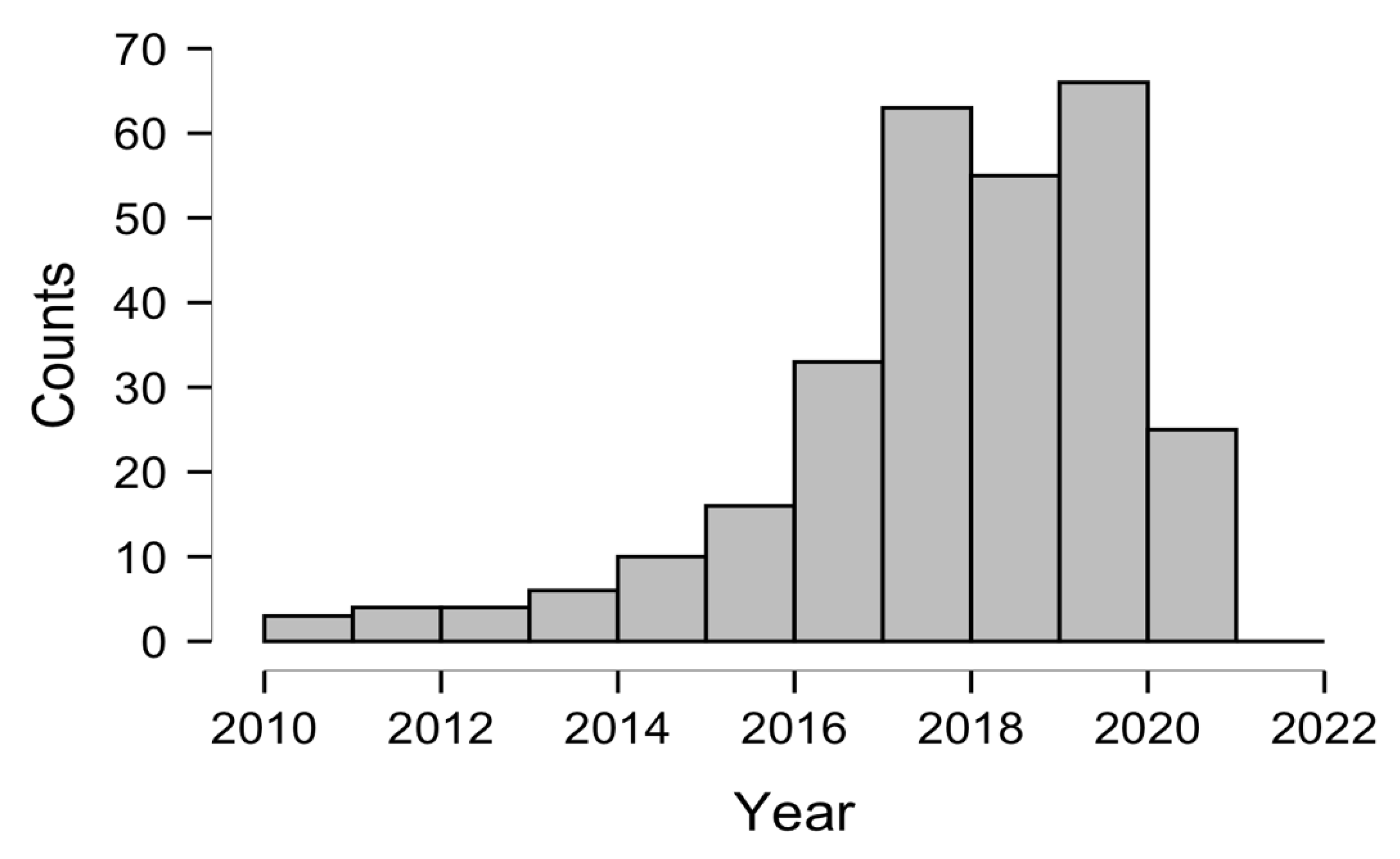
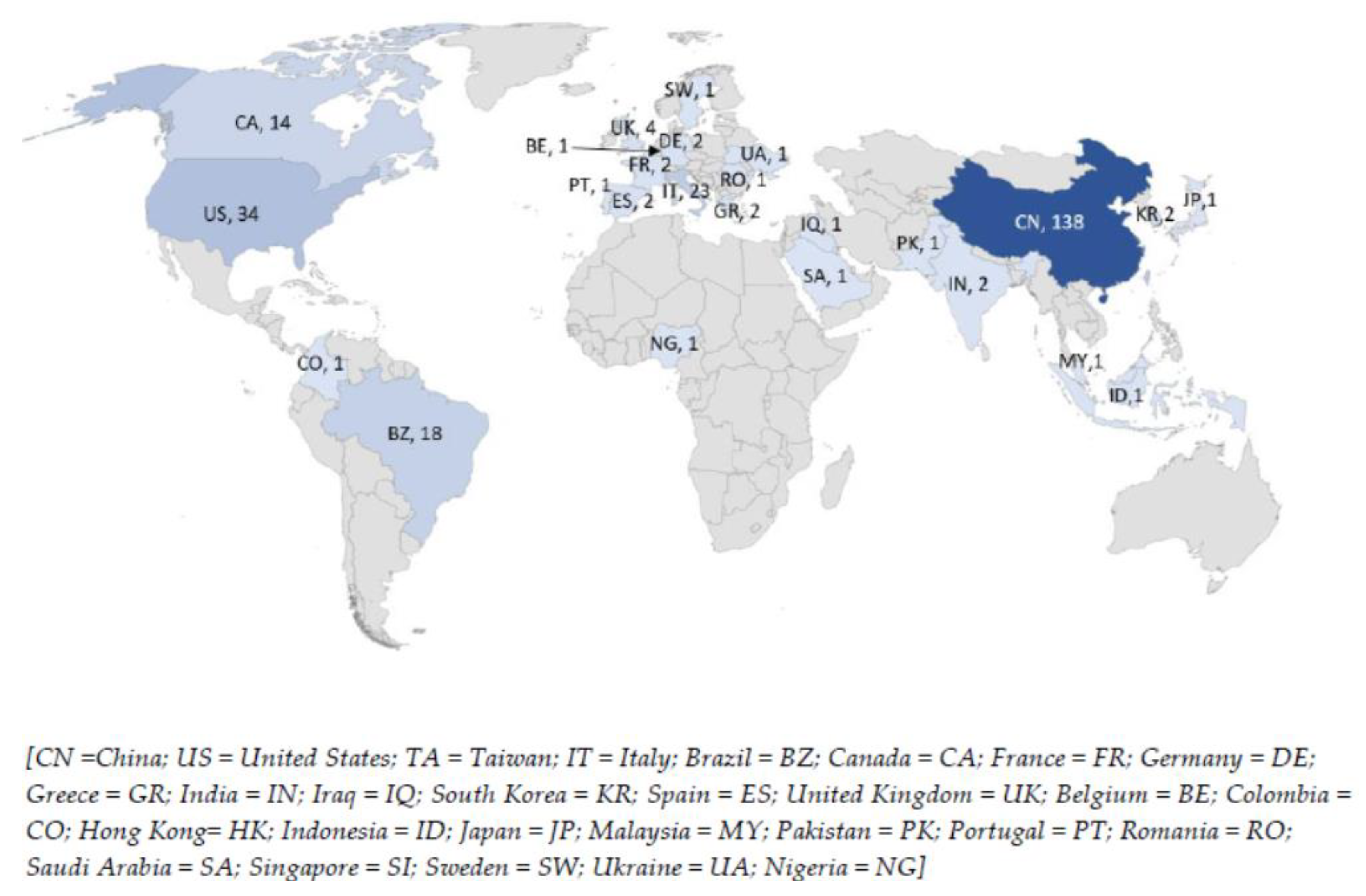
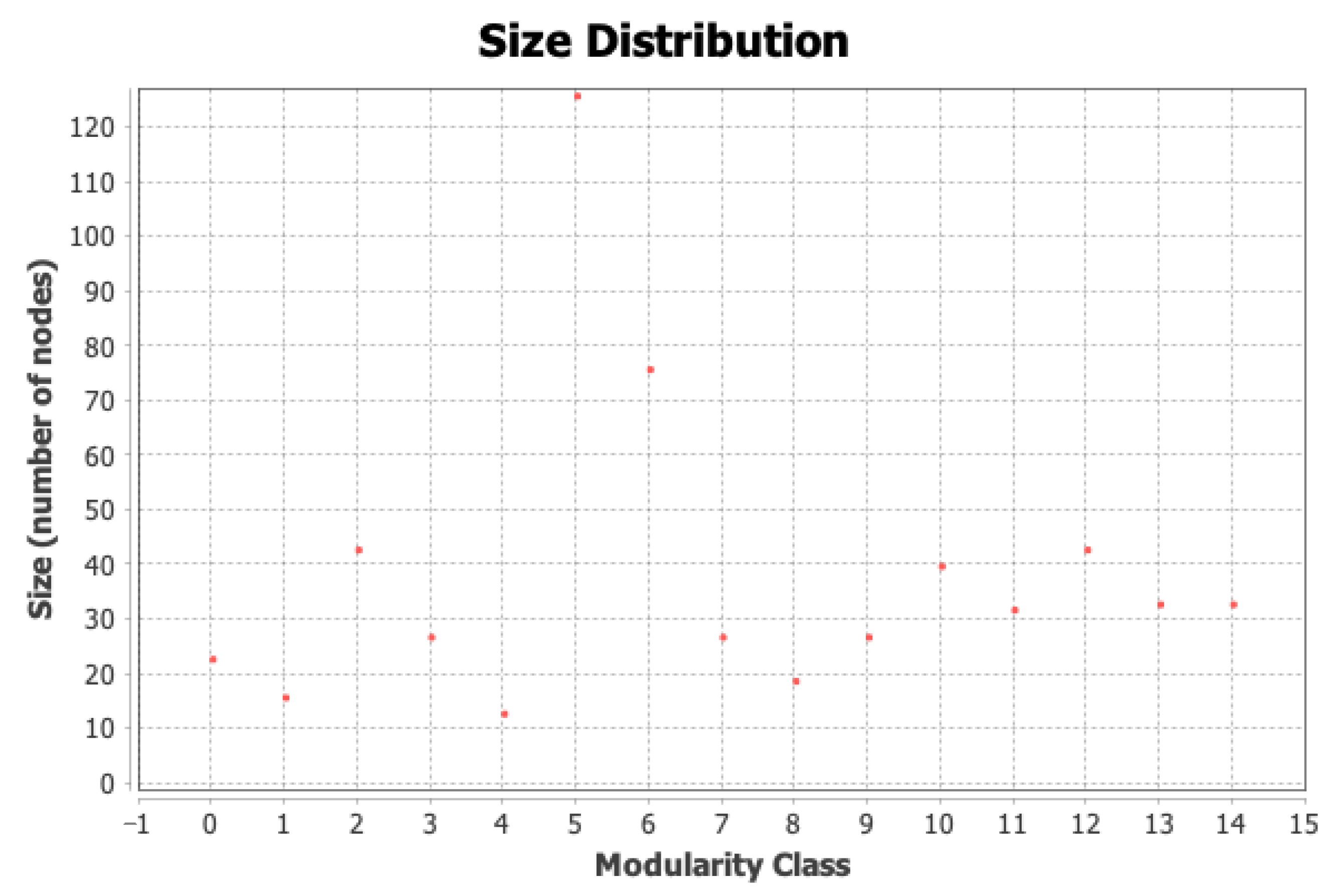
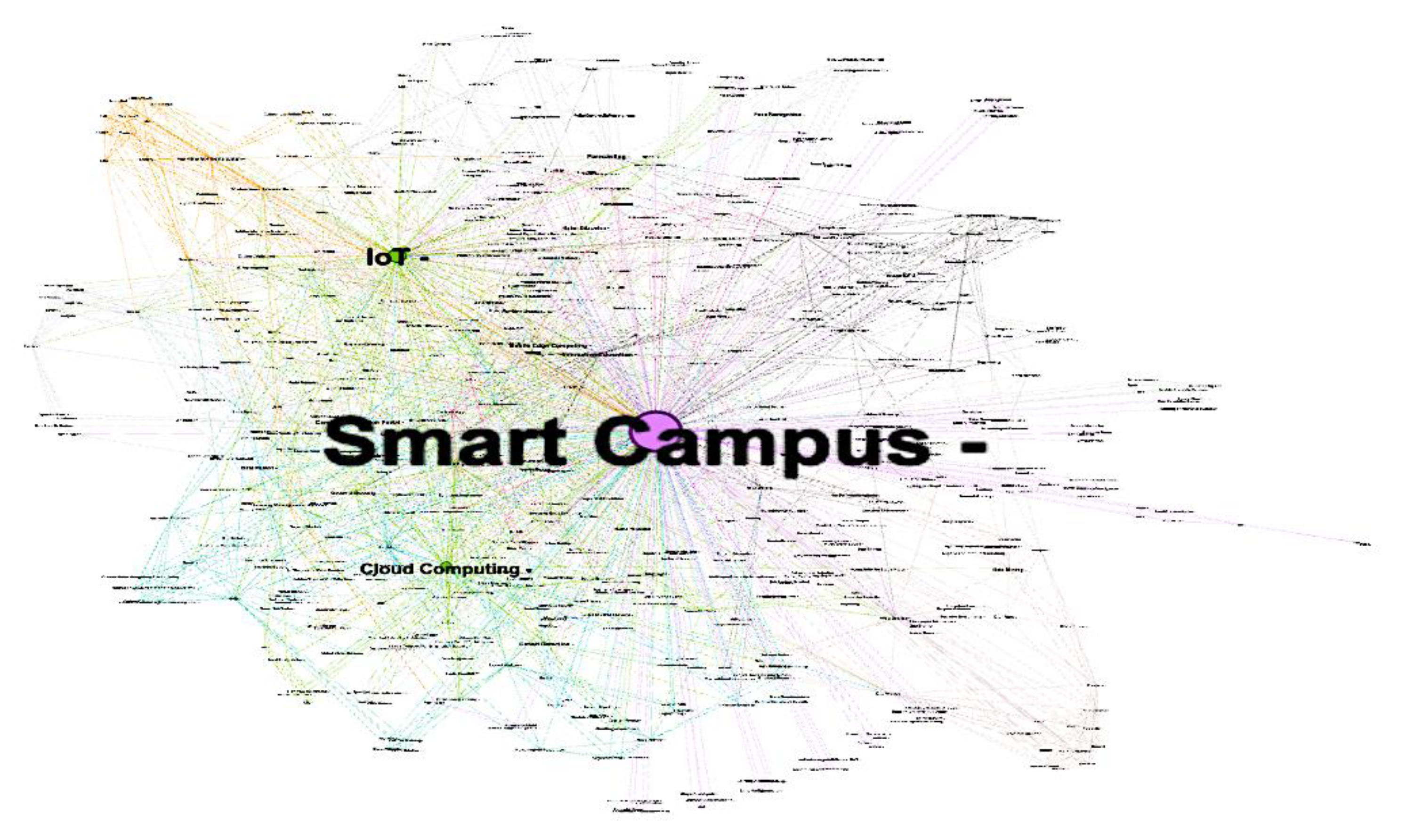
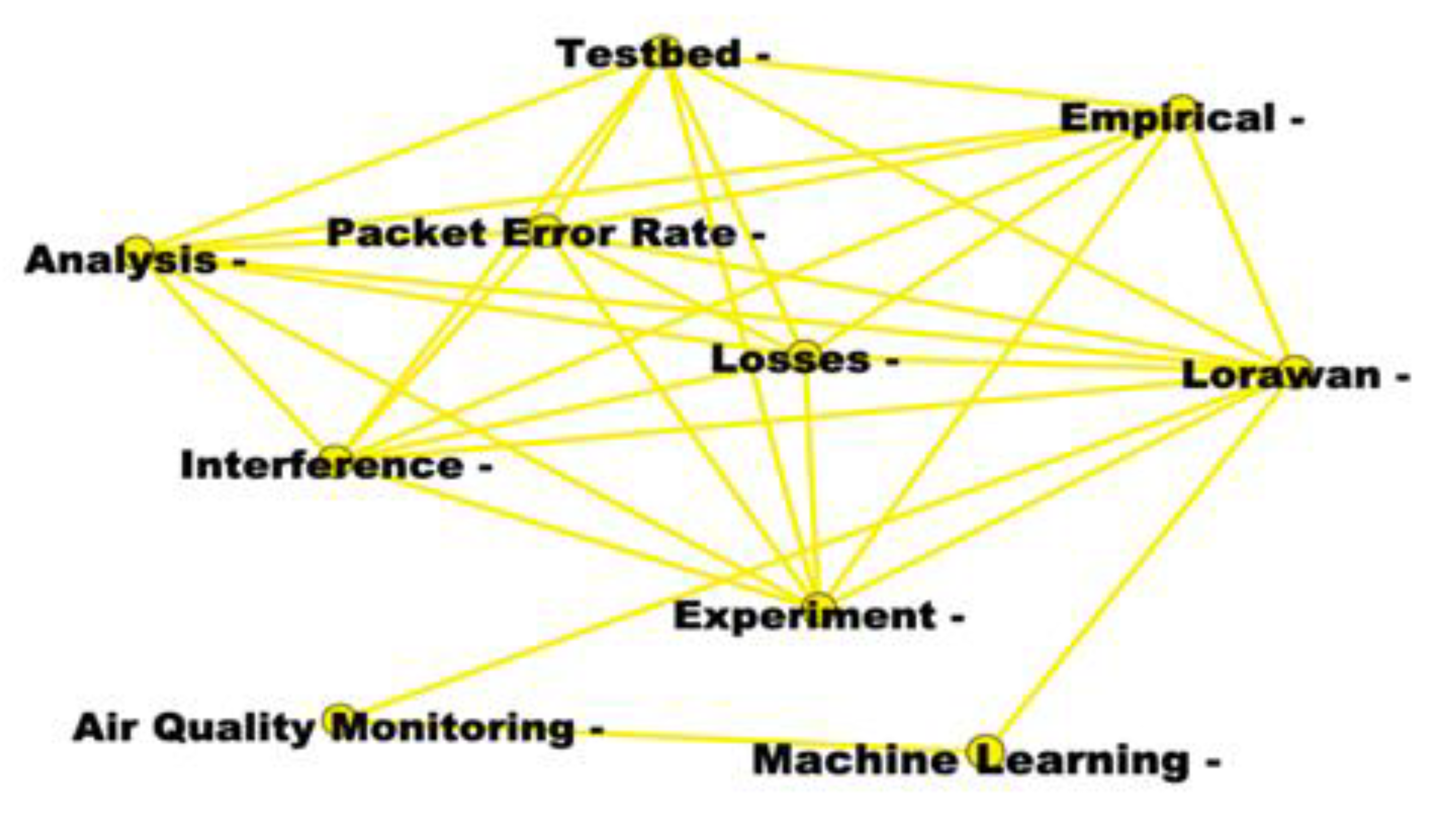
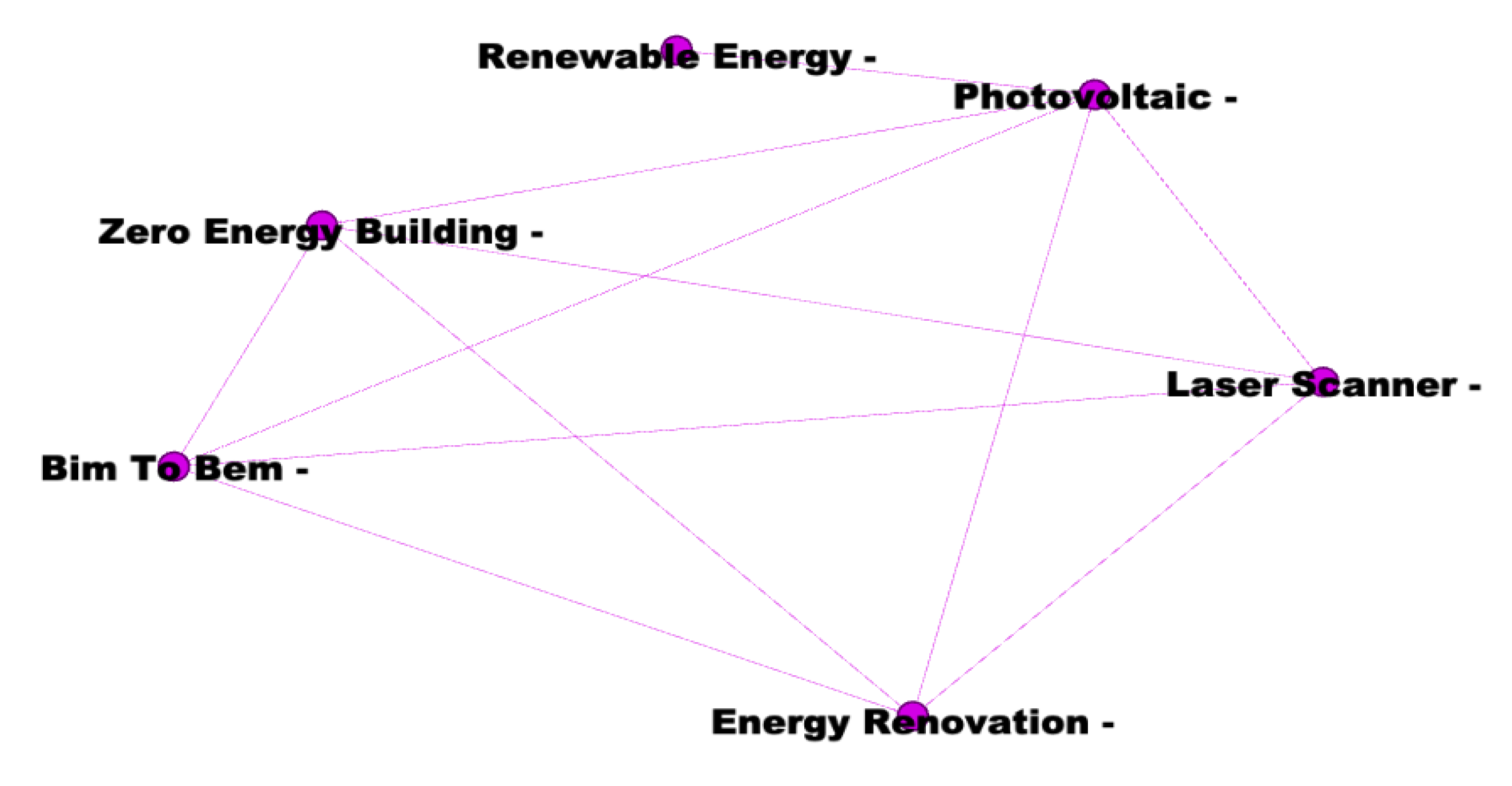
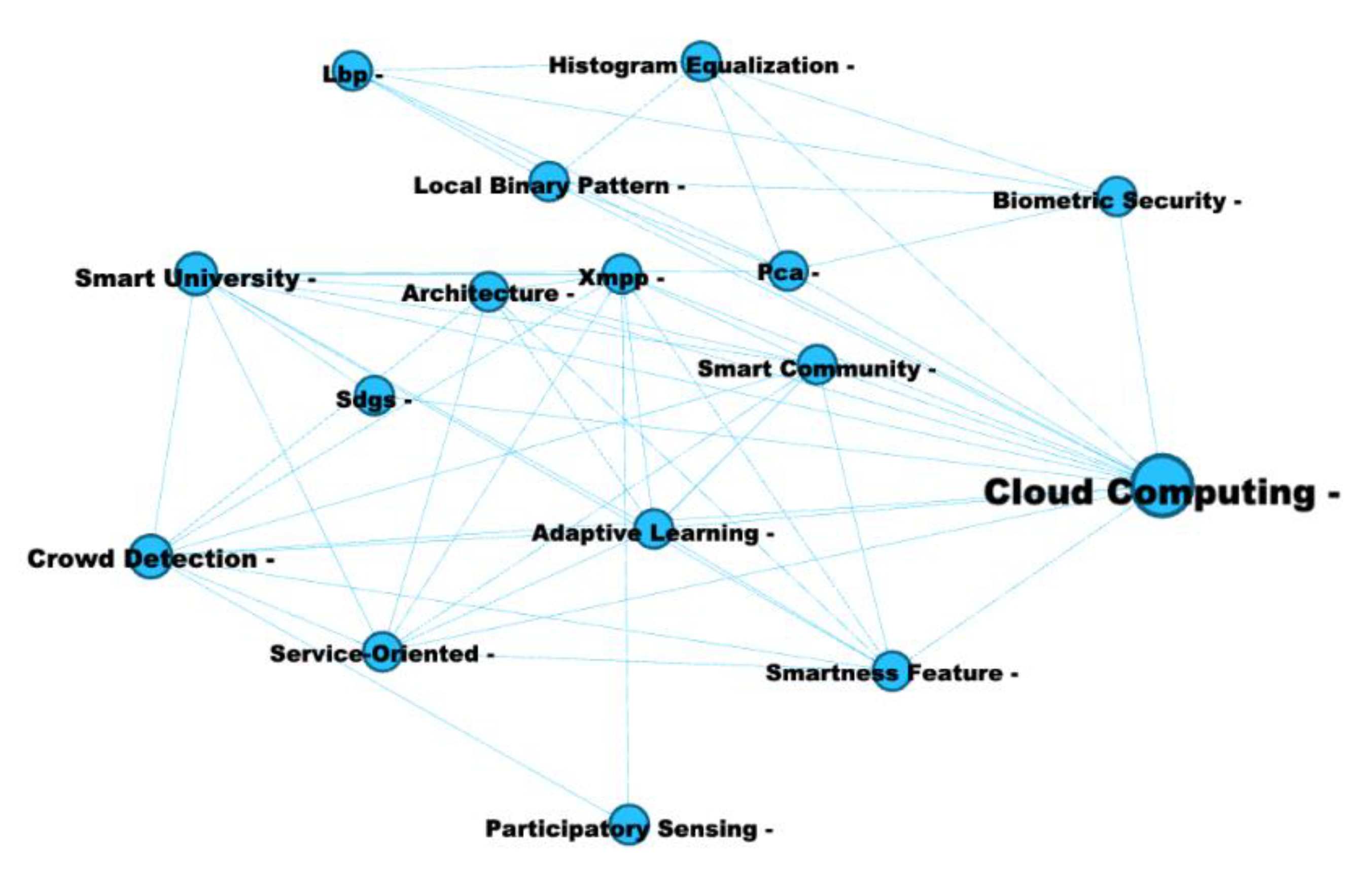
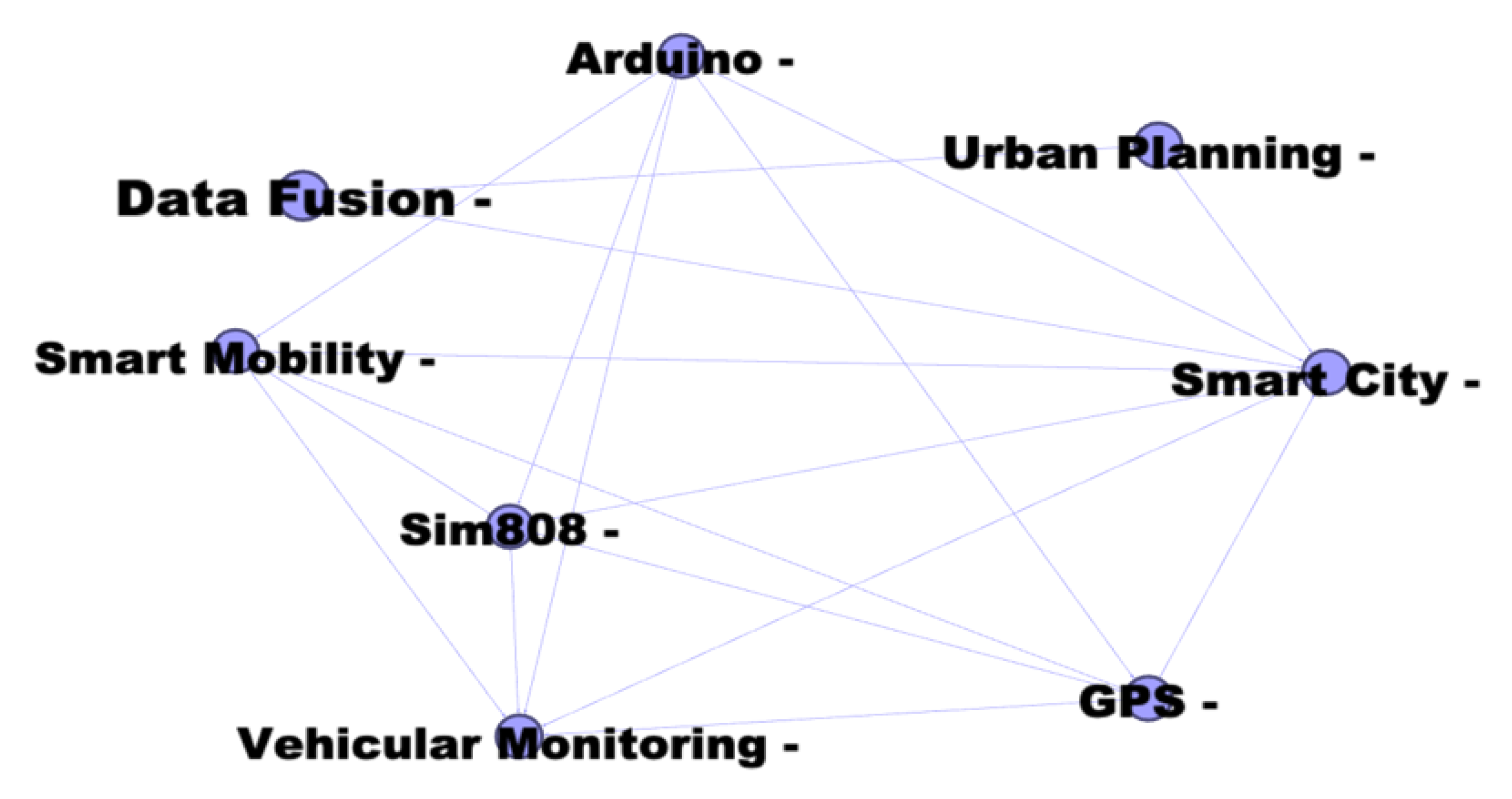
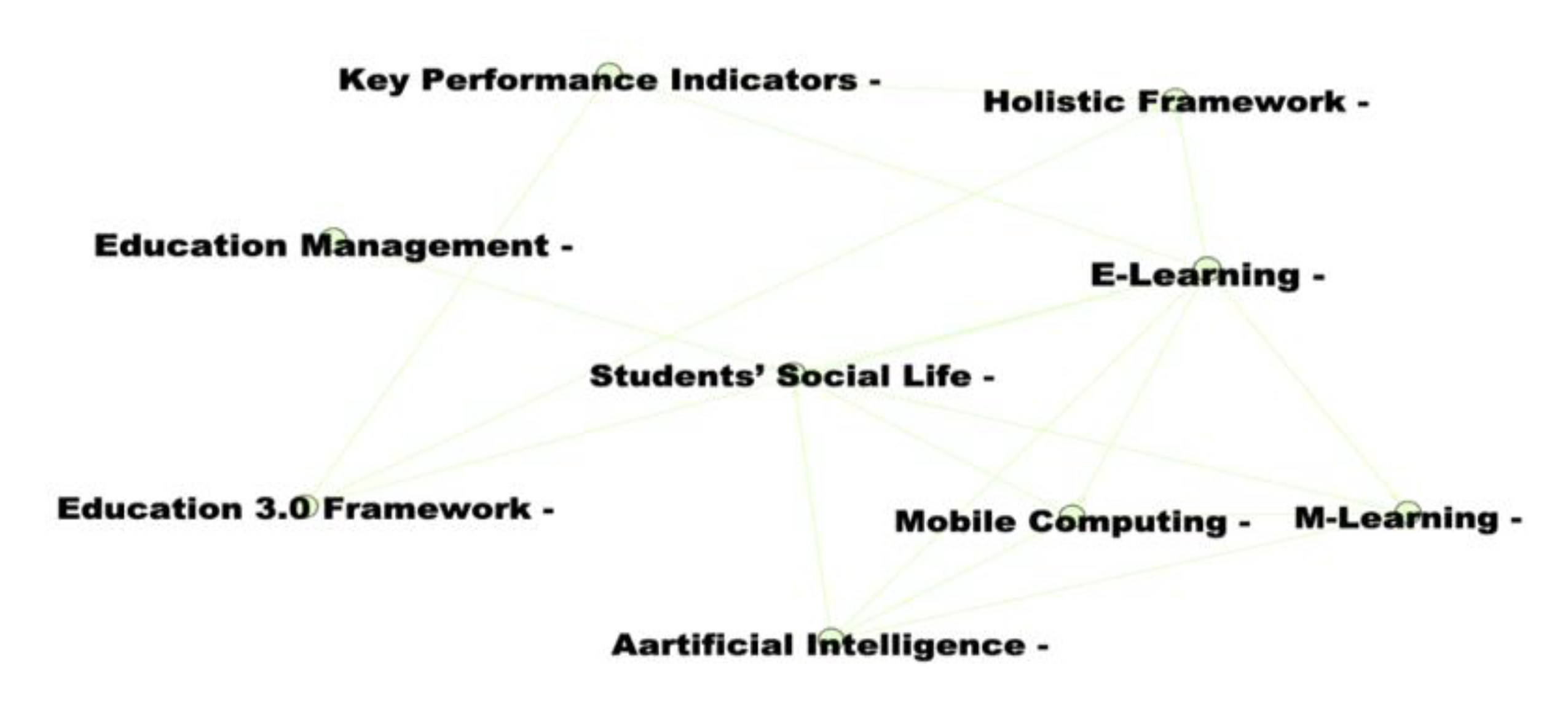
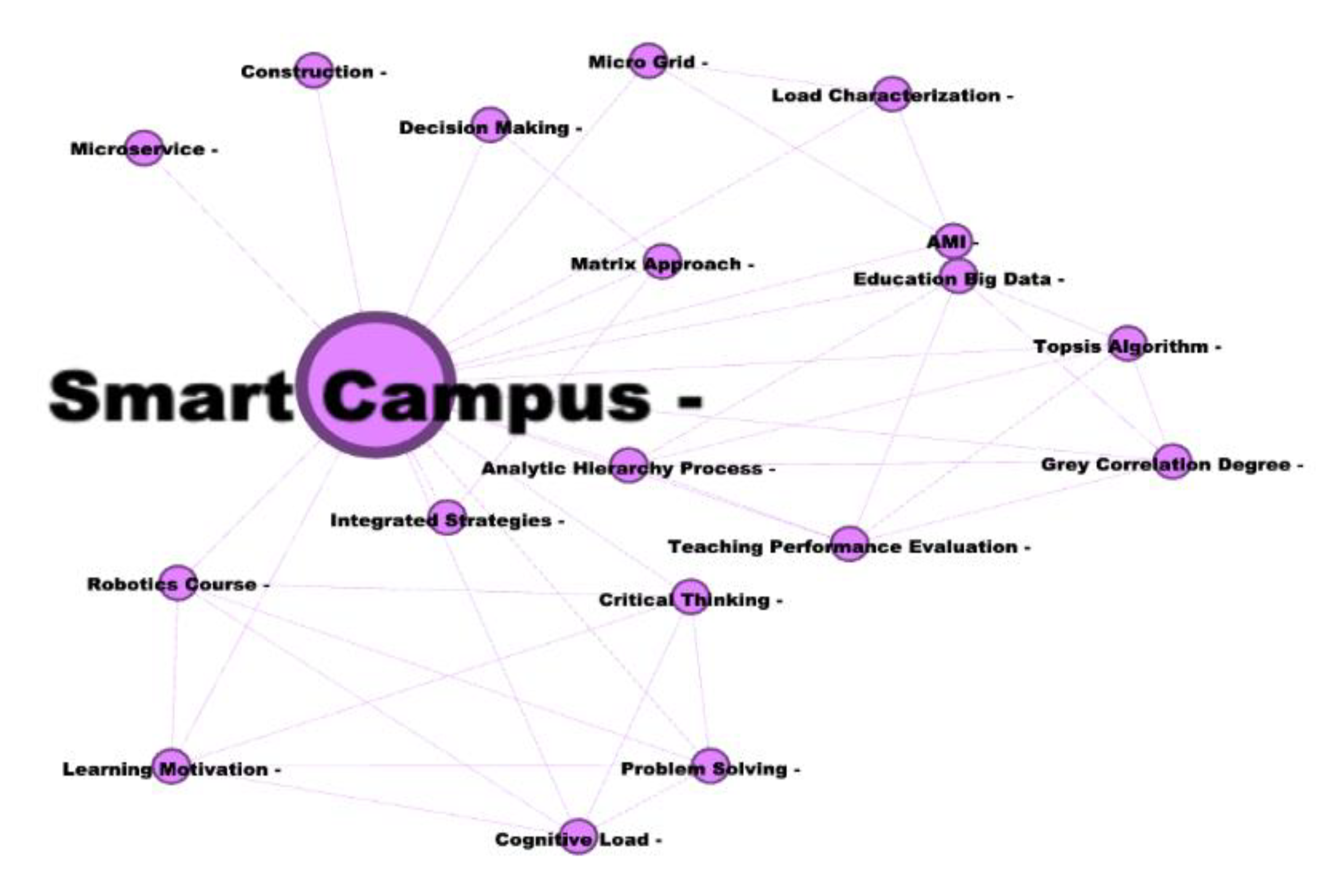
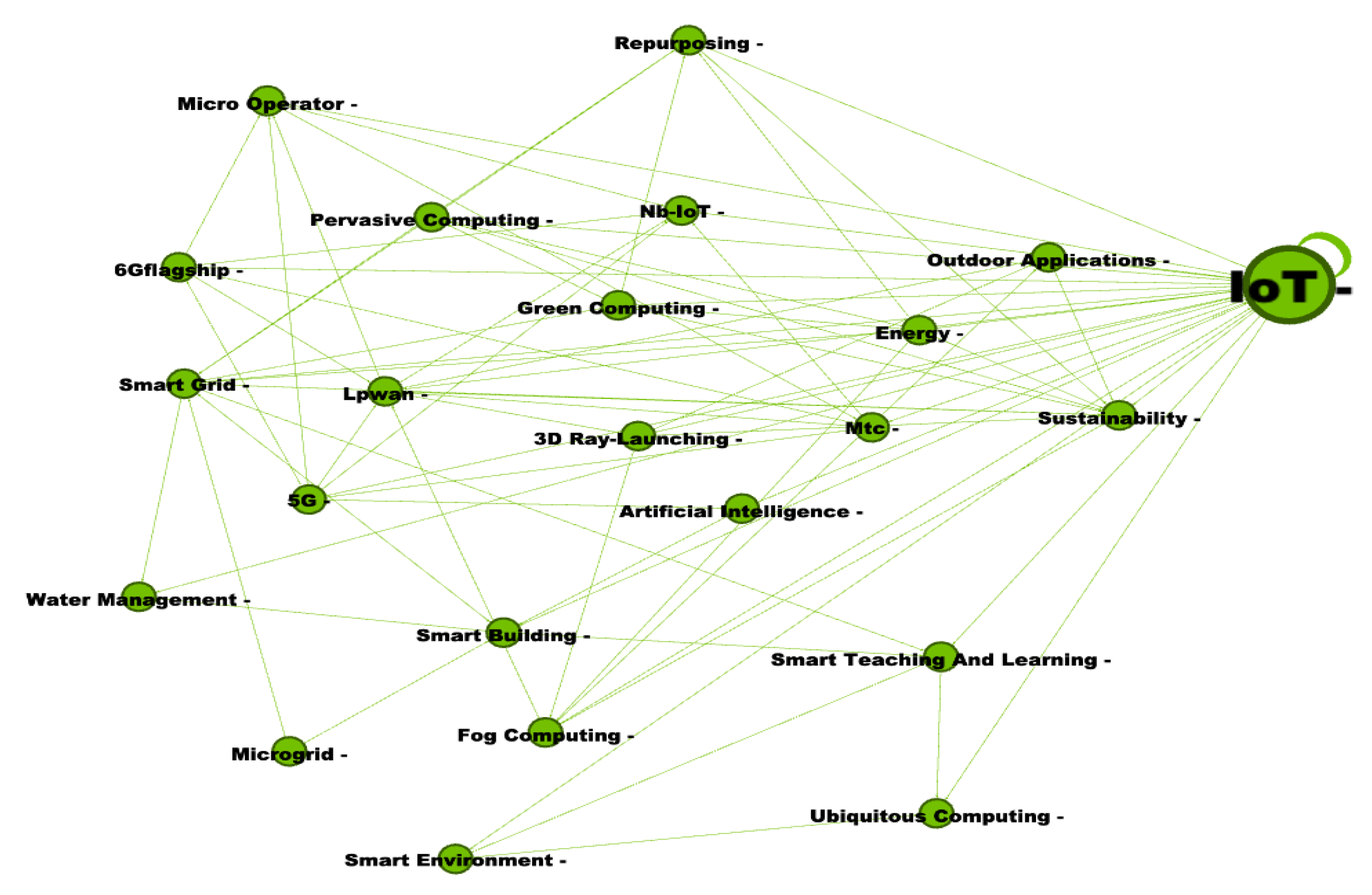
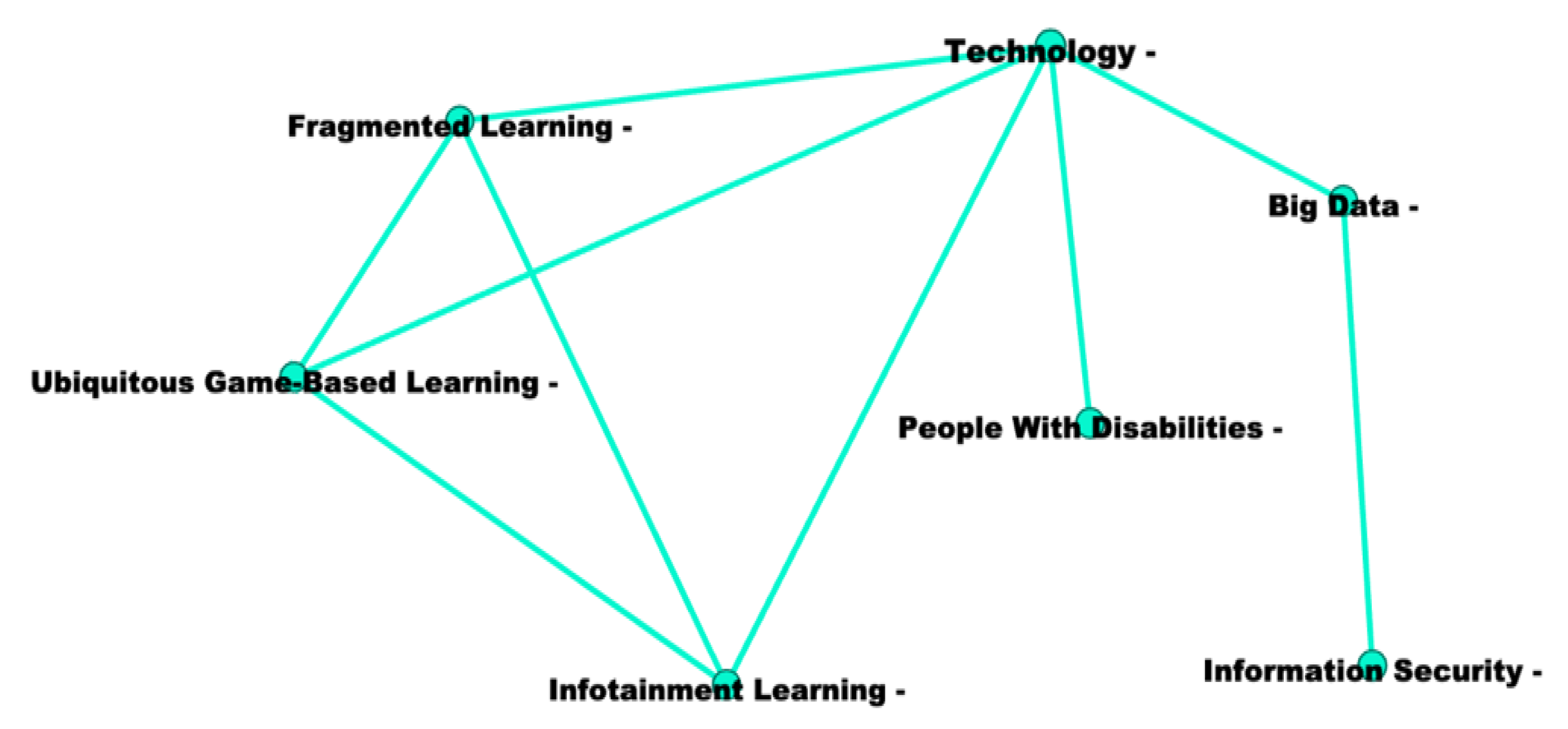
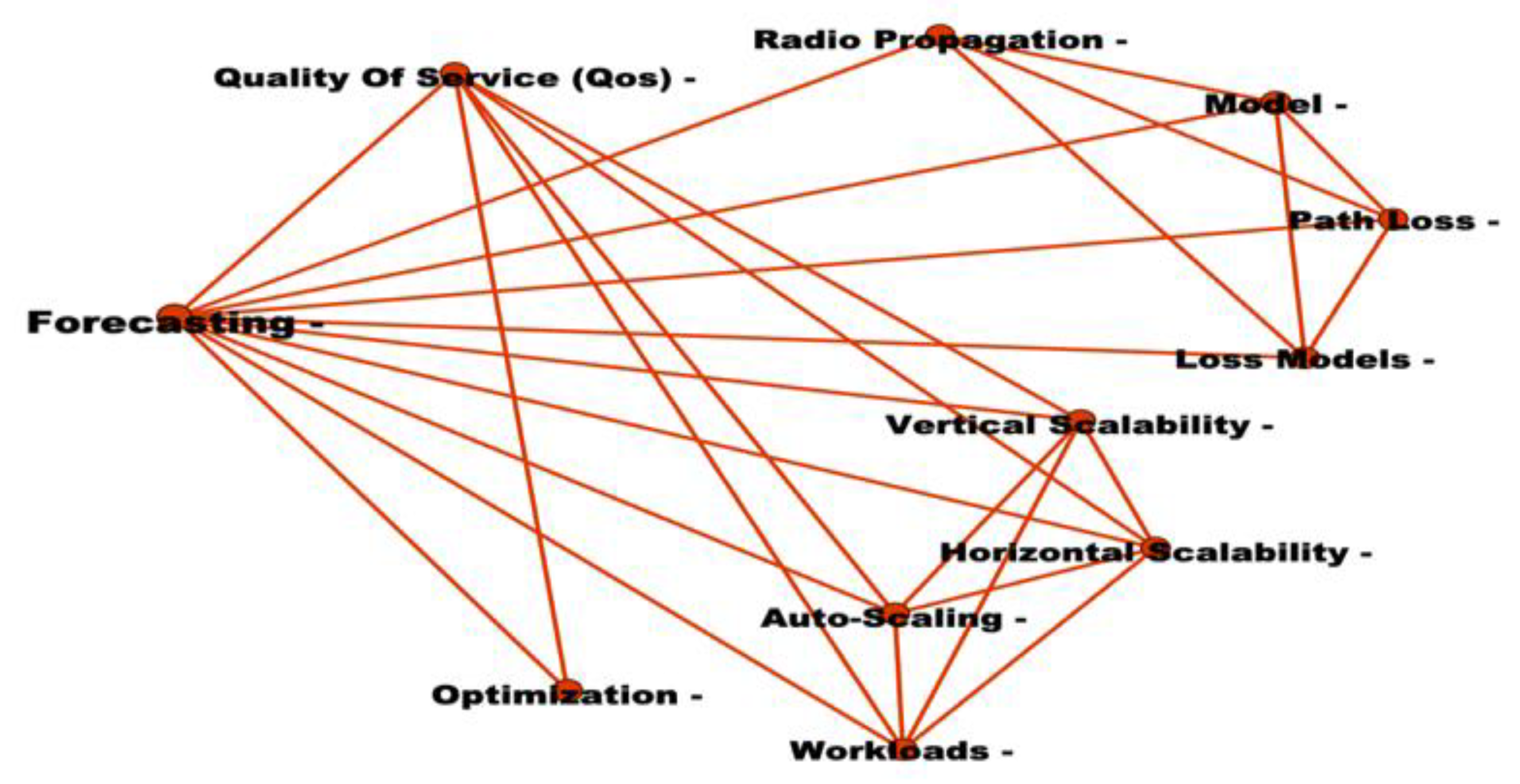
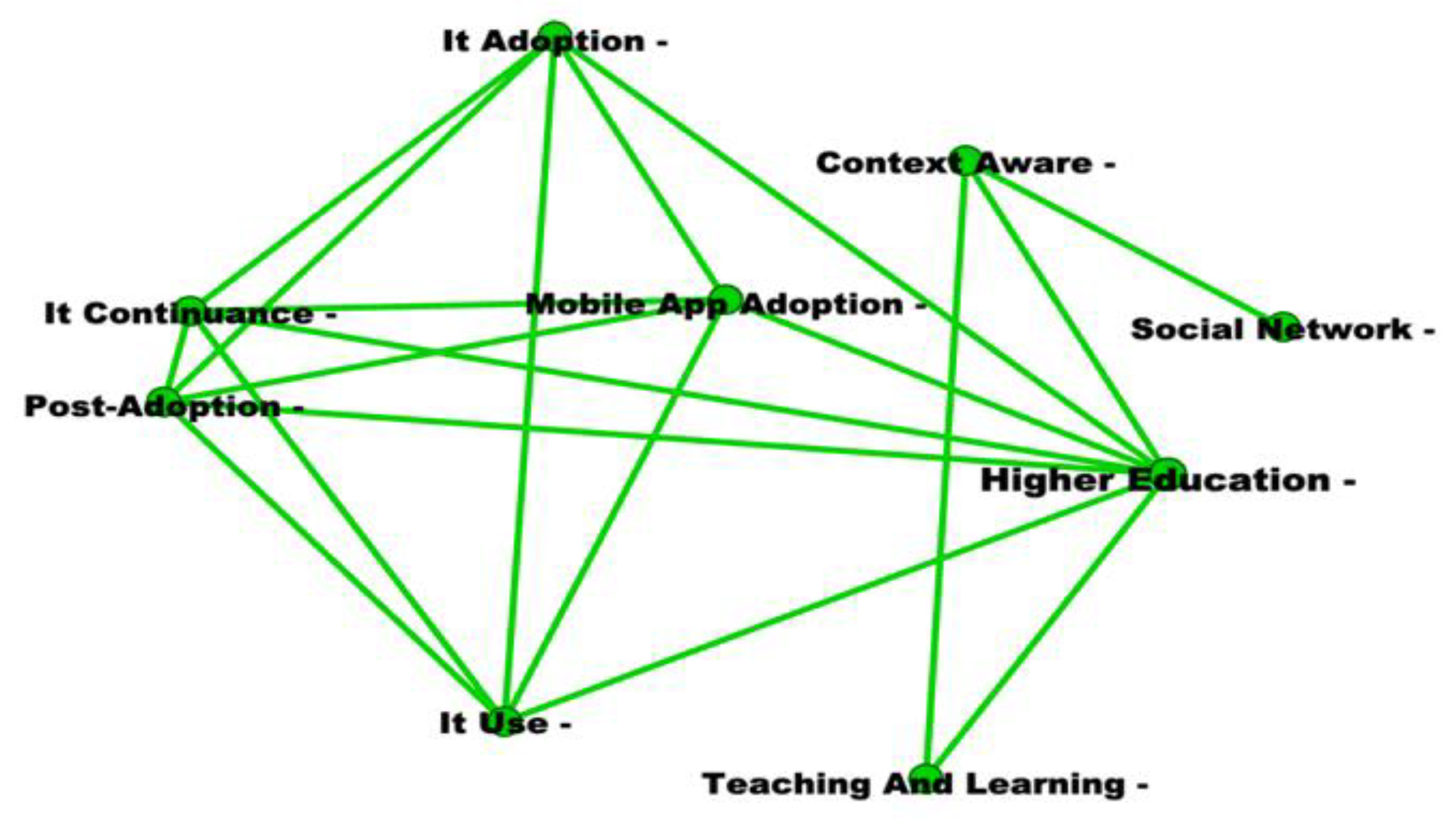

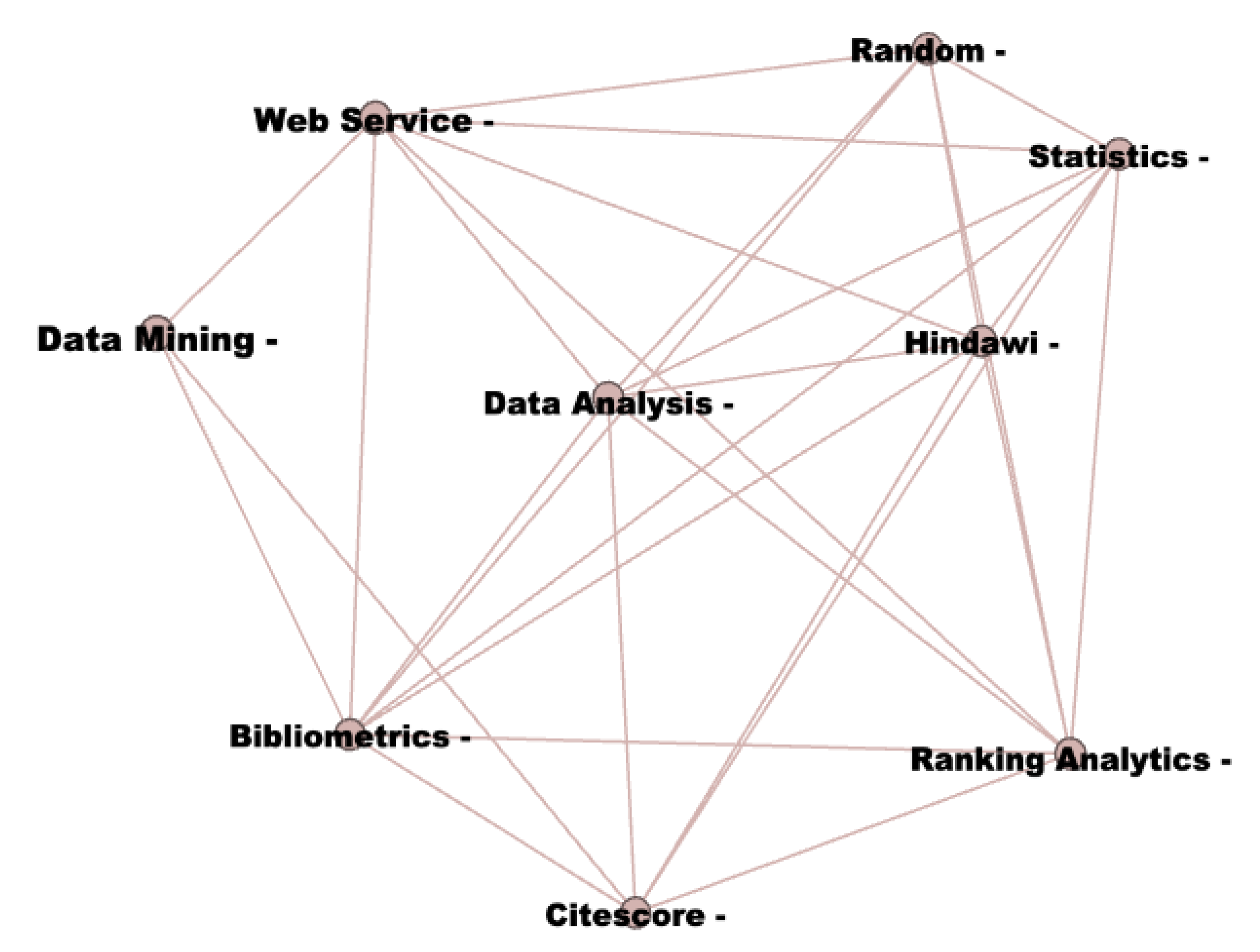
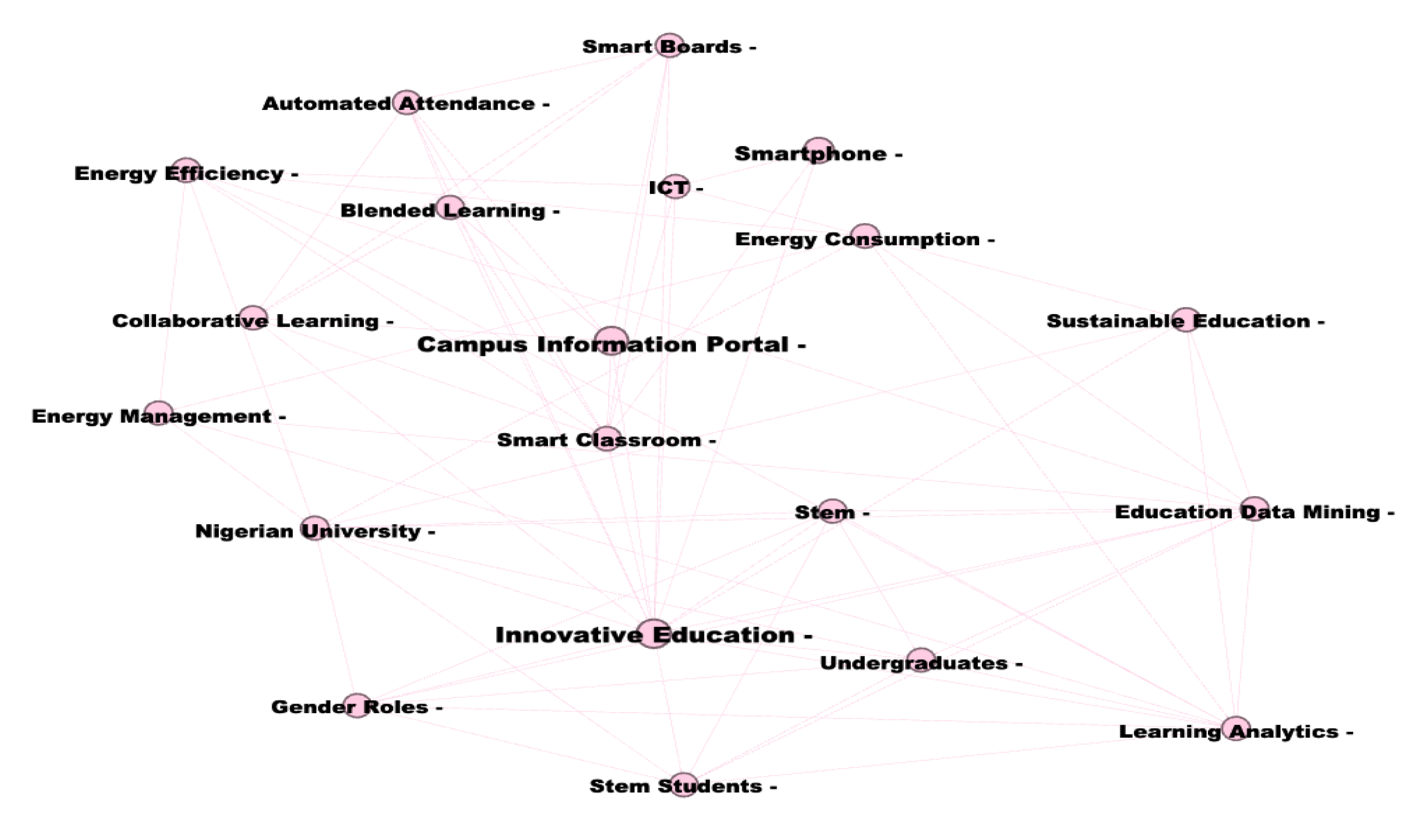
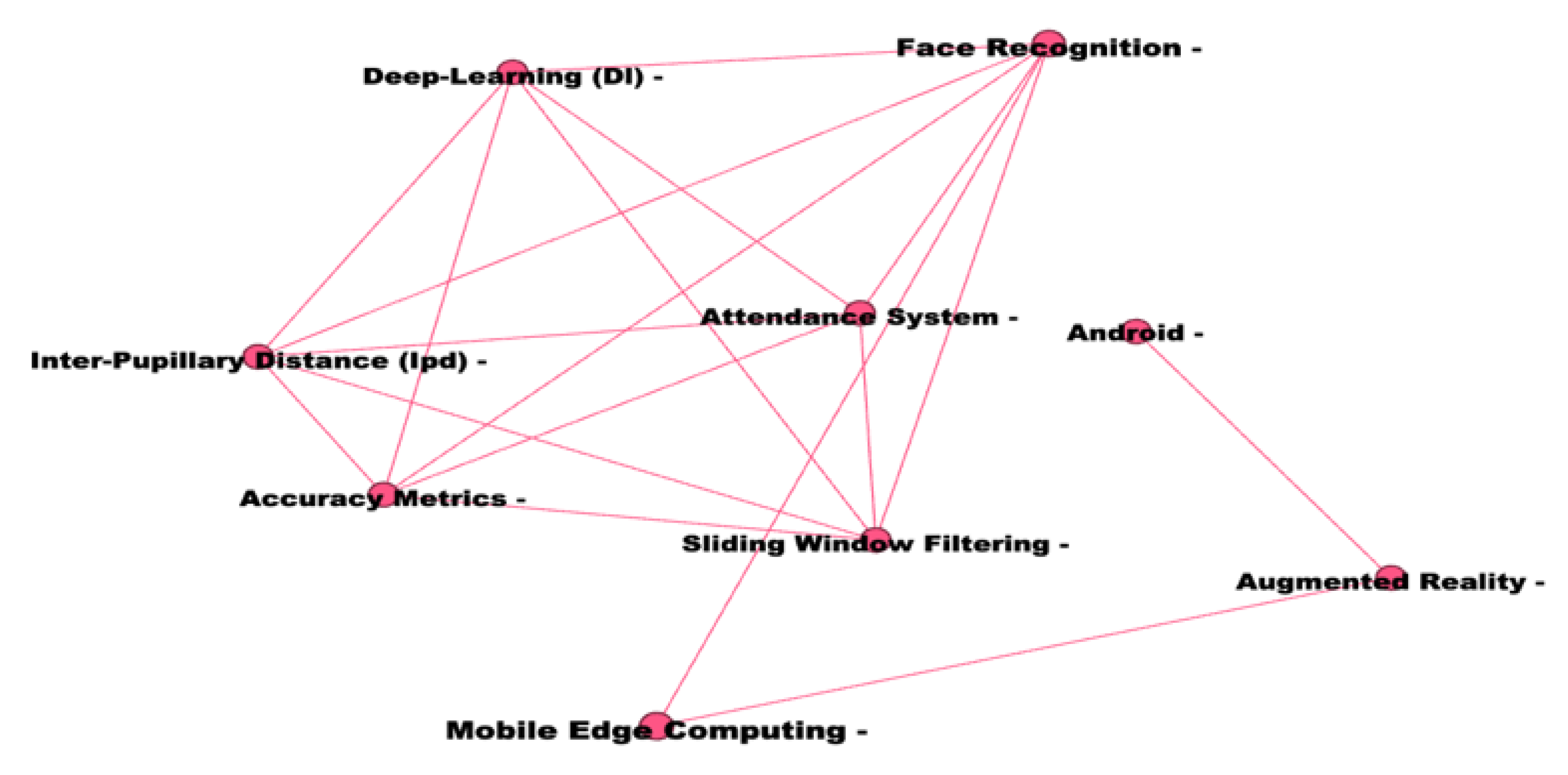
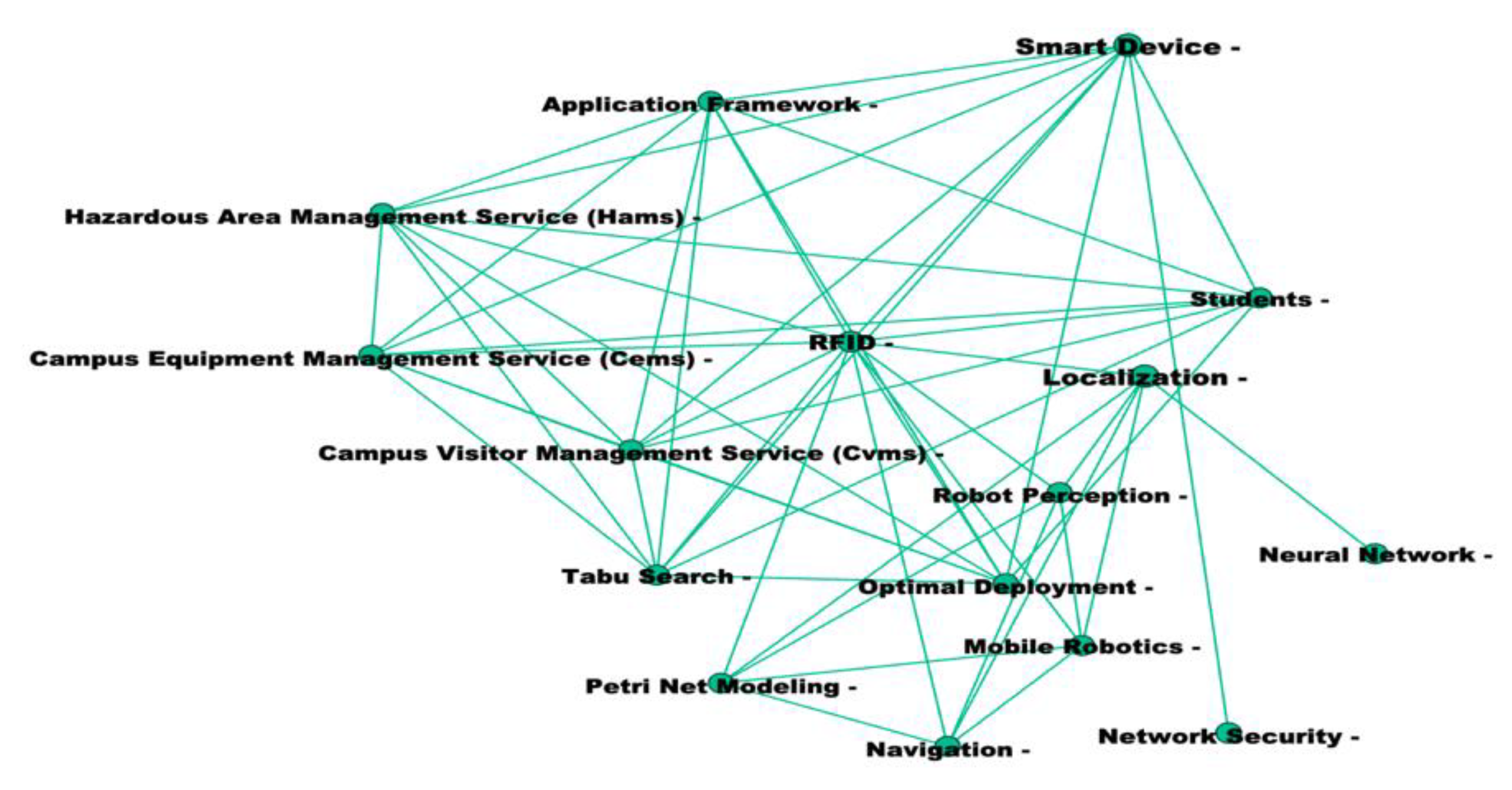
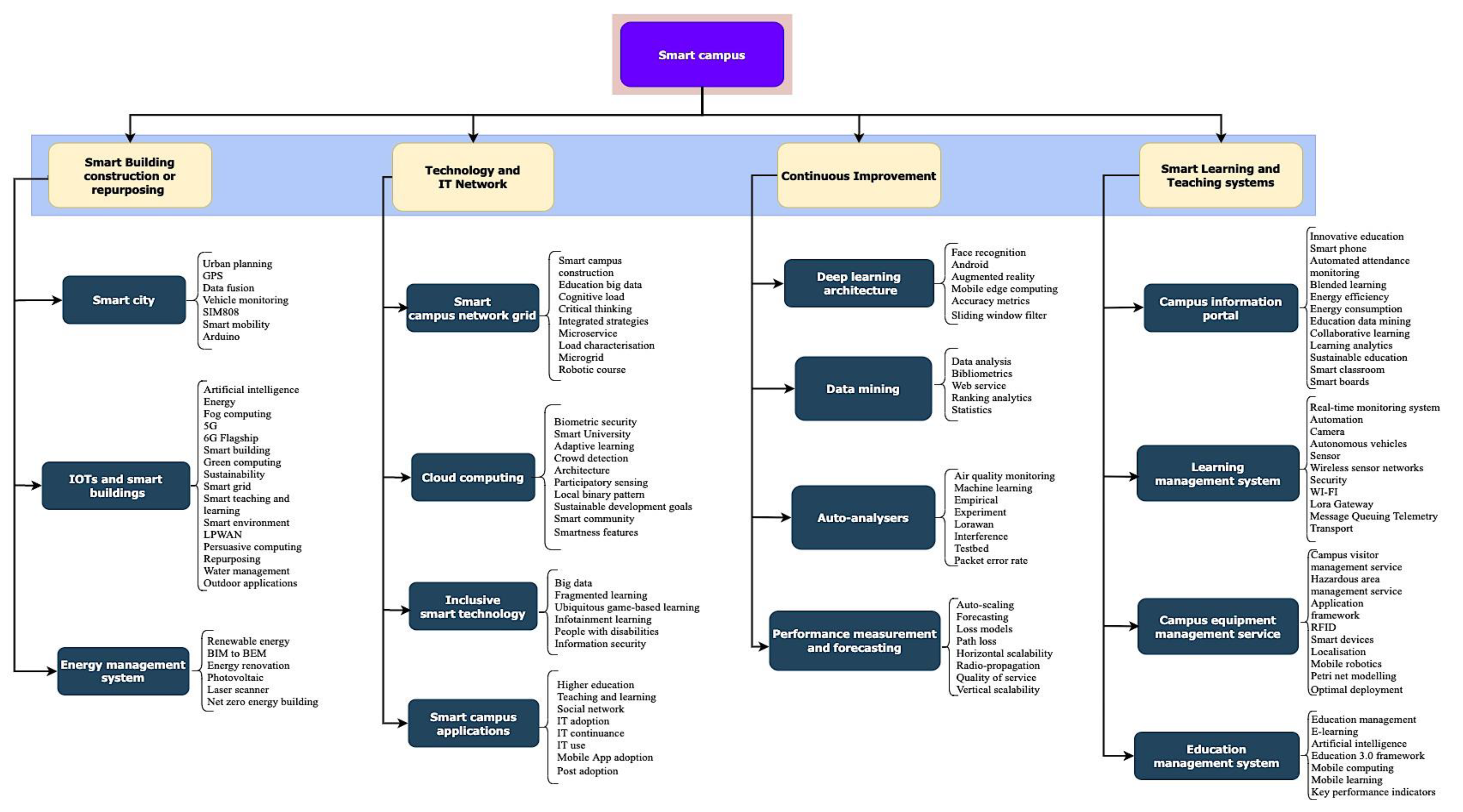
| Source | Input Variables |
|---|---|
| Web of Science and Scopus | “Smart” AND “campus” AND “construction” OR “procurement” AND “smart” AND campus OR “infrastructure” AND “smart” AND “campus” OR “smart” AND “campus” AND “technologies” OR “Colleges” AND “Universities” AND “smart” OR “Digital” AND “Campus” AND “students” |
| Limiters | 2011–2021 |
| ID | Modularity Number | Modularity Percentage (%) | Cluster Themes | Clustered Year of Publication |
|---|---|---|---|---|
| 1 | 5 | 21.80 | Smart campus network grid | 2018 |
| 2 | 6 | 13.15 | Internet of things (IoT) and smart buildings | 2020 |
| 3 | 2 | 7.44 | Cloud computing | 2020 |
| 4 | 12 | 7.44 | Campus information portal | 2020 |
| 5 | 10 | 6.92 | Learning management system | 2018 |
| 6 | 13 | 5.71 | Deep learning architecture | 2020 |
| 7 | 14 | 5.71 | Campus Equipment Management Service (CEMS) | 2012 |
| 8 | 11 | 5.54 | Data mining | 2018 |
| 9 | 3 | 4.67 | Smart city | 2018 |
| 10 | 7 | 4.67 | Inclusive smart technology | 2018 |
| 11 | 9 | 4.67 | Smart campus applications | 2020 |
| 12 | 0 | 3.98 | Auto-analysers | 2019 |
| 13 | 8 | 3.29 | Performance measurement and forecasting | 2020 |
| 14 | 1 | 2.77 | Energy management system | 2015 |
| 15 | 4 | 2.25 | Education management system | 2012 |
| Theme | Drivers | Harmonic Closeness Centrality | No. of Documents | % | Type of Publication |
|---|---|---|---|---|---|
| Auto-analysers | Air quality monitoring | 0.458 | 4 | 18.2% | Journal articles & conference papers |
| Machine learning | 0.422 | 6 | 27.3% | Journal articles & conference paper | |
| Empirical | 0.442 | 1 | 4.5% | Journal article | |
| Experiment | 0.441 | 2 | 9.1% | Journal articles & conference paper | |
| LoRaWAN | 0.421 | 5 | 22.7% | Journal articles & conference paper | |
| Interference | 0.394 | 1 | 4.5% | Journal article | |
| Testbed | 0.445 | 2 | 9.1% | Journal articles & conference paper | |
| Packet error rate | 0.392 | 1 | 4.5% | Journal article |
| Theme | Drivers | Harmonic Closeness Centrality | No. of Documents | % | Type of Publication |
|---|---|---|---|---|---|
| Energy management system (EMS) | Renewable energy | 0.396 | 2 | 25.0% | Journal articles & conference papers |
| BIM to BEM | 0.399 | 1 | 12.5% | Journal article | |
| Energy renovation | 0.397 | 1 | 12.5% | Journal article | |
| Photovoltaic | 0.399 | 2 | 25.0% | Journal articles | |
| Laser scanner | 0.394 | 1 | 12.5% | Journal article | |
| Net-zero energy building | 0.359 | 1 | 12.5% | Conference paper |
| Theme | Drivers | Harmonic Closeness Centrality | No. of Documents | % | Type of Publication |
|---|---|---|---|---|---|
| Cloud computing | Biometric security | 0.420 | 2 | 5.9% | Journal article & Conference paper |
| Smart University | 0.442 | 11 | 32.4% | Journal articles & conference papers | |
| Adaptive learning | 0.478 | 2 | 5.9% | Journal articles | |
| Crowd detection | 0.478 | 6 | 17.6% | Journal articles & conference papers | |
| Architecture | 0.474 | 2 | 5.9% | Journal articles | |
| Participatory sensing | 0.401 | 3 | 8.8% | Journal articles & conference papers | |
| Local binary pattern | 0.396 | 2 | 5.9% | Journal article & Conference paper | |
| Sustainable development goals (SDGs) | 0.360 | 4 | 11.8% | Journal articles | |
| Smart community | 0.320 | 1 | 2.9% | Conference paper | |
| Smartness features | 0.358 | 1 | 2.9% | Journal article |
| Theme | Drivers | Harmonic Closeness Centrality | No. of Documents | % | Type of Publication |
|---|---|---|---|---|---|
| Smart city | Urban planning | 0.394 | 2 | 12.5% | Conference papers |
| GPS | 0.414 | 3 | 18.8% | Journal articles & conference papers | |
| Data fusion | 0.459 | 4 | 25.0% | Journal articles & conference paper | |
| Vehicle monitoring | 0.434 | 2 | 12.5% | Journal articles & conference paper | |
| SIM808 | 0.396 | 1 | 6.3% | Journal articles & conference paper | |
| Smart mobility | 0.311 | 3 | 18.8% | Journal articles & conference papers | |
| Arduino | 0.400 | 1 | 6.3% | Conference paper |
| Theme | Drivers | Harmonic Closeness Centrality | No. of Documents | % | Type of Publication |
|---|---|---|---|---|---|
| Education management system | Education management | 0.399 | 3 | 11.5% | Journal articles |
| E-learning | 0.473 | 8 | 30.8% | Journal articles & conference papers | |
| Artificial intelligence | 0.412 | 5 | 19.2% | Journal articles & conference papers | |
| Education 3.0 framework | 0.396 | 1 | 3.8% | Conference paper | |
| Mobile computing | 0.393 | 6 | 23.1% | Journal articles & conference papers | |
| Mobile learning | 0.395 | 1 | 3.8% | Conference paper | |
| Key performance indicators | 0.390 | 2 | 7.7% | Journal articles |
| Theme | Label | Harmonic Closeness Centrality | No. of Documents | % | Type of Publication |
|---|---|---|---|---|---|
| Smart campus network grid | Smart campus | 0.683 | 285 | 95.3% | Journal articles & conference papers |
| Construction | 0.398 | 2 | 0.7% | Conference papers | |
| Education big data | 0.402 | 2 | 0.7% | Journal articles | |
| Cognitive load | 0.399 | 1 | 0.3% | Conference paper | |
| Critical thinking | 0.397 | 1 | 0.3% | Journal article | |
| Integrated strategies | 0.403 | 2 | 0.7% | Journal article & Conference paper | |
| Microservice | 0.396 | 2 | 0.7% | Journal articles | |
| Load characterisation | 0.395 | 1 | 0.3% | Conference paper | |
| Microgrid | 0.392 | 2 | 0.7% | Journal articles | |
| Robotic course | 0.390 | 1 | 0.3% | Journal article |
| Theme | Label | Harmonic Closeness Centrality | No. of Documents | % | Type of Publication |
|---|---|---|---|---|---|
| Internet of things (IoTs) and smart buildings | Artificial intelligence | 0.641 | 5 | 9.1% | Journal articles & conference paper |
| Energy | 0.467 | 2 | 3.6% | Journal articles | |
| Fog computing | 0.452 | 5 | 9.1% | Journal articles & conference papers | |
| 5G | 0.425 | 3 | 5.5% | Journal articles | |
| 6G Flagship | 0.401 | 1 | 1.8% | Journal article | |
| Smart building | 0.362 | 4 | 7.3% | Journal papers | |
| Green computing | 0.401 | 1 | 1.8% | Conference paper | |
| Sustainability | 0.271 | 10 | 18.2% | Journal articles & conference papers | |
| Smart grid | 0.297 | 6 | 10.9% | Journal articles & conference paper | |
| Smart teaching and learning | 0.291 | 3 | 5.5% | Conference paper | |
| Smart environment | 0.226 | 4 | 7.3% | Conference paper | |
| Lower power wide area network (LPWAN) | 0.365 | 3 | 5.5% | Journal articles & conference paper | |
| Persuasive computing | 0.360 | 1 | 1.8% | Journal paper | |
| Repurposing | 0.359 | 3 | 5.5% | Journal articles & conference paper | |
| Water management | 0.359 | 3 | 5.5% | Journal articles | |
| Outdoor applications | 0.360 | 1 | 1.8% | Journal article |
| Theme | Label | Harmonic Closeness Centrality | No. of Documents | % | Type of Publication |
|---|---|---|---|---|---|
| Inclusive smart technology | Big data | 0.517 | 14 | 53.8% | Journal articles & conference paper |
| Fragmented learning | 0.397 | 1 | 3.8% | Journal article | |
| Ubiquitous game-based learning | 0.351 | 5 | 19.2% | Journal articles | |
| Infotainment learning | 0.395 | 1 | 3.8% | Journal article | |
| People with disabilities | 0.390 | 2 | 7.7% | Journal articles & conference paper | |
| Information security | 0.393 | 3 | 11.5% | Journal articles & conference paper |
| Theme | Drivers | Harmonic Closeness Centrality | No. of Documents | % | Type of Publication |
|---|---|---|---|---|---|
| Performance measurement and forecasting | Auto-scaling | 0.462 | 1 | 7.7% | Journal article |
| Forecasting | 0.460 | 3 | 23.1% | Journal articles | |
| Loss models | 0.400 | 2 | 15.4% | Journal article & Survey data | |
| Path loss | 0.402 | 2 | 15.4% | Journal article & Survey data | |
| Horizontal scalability | 0.442 | 1 | 7.7% | Journal article | |
| Radio-propagation | 0.392 | 2 | 15.4% | Journal articles | |
| Quality of service | 0.434 | 1 | 7.7% | Survey data | |
| Vertical scalability | 0.402 | 1 | 7.7% | Journal article |
| Theme | Label | Harmonic Closeness Centrality | No. of Documents | % | Type of Publication |
|---|---|---|---|---|---|
| Smart campus applications | Higher education | 0.460 | 5 | 33.3% | Journal articles & conference paper |
| Teaching and learning | 0.492 | 2 | 13.3% | Journal articles | |
| Social network | 0.393 | 3 | 20.0% | Journal articles & conference paper | |
| IT adoption | 0.491 | 1 | 6.7% | Conference paper | |
| IT continuance | 0.399 | 1 | 6.7% | Conference paper | |
| IT use | 0.397 | 1 | 6.7% | Conference paper | |
| Mobile App adoption | 0.394 | 1 | 6.7% | Conference paper | |
| Post-adoption | 0.391 | 1 | 6.7% | Conference paper |
| Theme | Label | Harmonic Closeness Centrality | No. of Documents | % | Type of Publication |
|---|---|---|---|---|---|
| Learning management system | Real-time monitoring system | 0.447 | 2 | 9.1% | Journal article & Conference paper |
| Automation | 0.453 | 2 | 9.1% | Journal article | |
| Camera | 0.451 | 1 | 4.5% | Journal article | |
| Autonomous vehicles | 0.436 | 1 | 4.5% | Conference paper | |
| Sensor | 0.417 | 4 | 18.2% | Journal articles & conference paper | |
| Wireless sensor networks | 0.392 | 3 | 13.6% | Journal articles & conference paper | |
| Security | 0.396 | 4 | 18.2% | Journal articles & conference paper | |
| WI-FI | 0.305 | 2 | 9.1% | Conference papers | |
| Lora Gateway | 0.408 | 1 | 4.5% | Journal article | |
| Message Queuing Telemetry Transport (MQTT) | 0.405 | 2 | 9.1% | Journal article & Conference paper |
| Theme | Drivers | Harmonic Closeness Centrality | No. of Documents | % | Type of Publication |
|---|---|---|---|---|---|
| Data mining | Data analysis | 0.464 | 7 | 30.4% | Journal articles & conference papers |
| Bibliometrics | 0.427 | 4 | 17.4% | Journal articles, Conference papers & Survey data | |
| Web service | 0.392 | 4 | 17.4% | Journal articles | |
| Ranking analytics | 0.396 | 4 | 17.4% | Journal articles& survey data | |
| Statistics | 0.279 | 4 | 17.4% | Journal articles & survey data |
| Theme | Drivers | Harmonic Closeness Centrality | No. of Documents | % | Type of Publication |
|---|---|---|---|---|---|
| Campus information portal | Innovative education | 0.504 | 1 | 2.3% | Journal article |
| Smartphone | 0.406 | 1 | 2.3% | Conference paper | |
| Automated attendance monitoring | 0.446 | 1 | 2.3% | Conference paper | |
| Blended learning | 0.438 | 1 | 2.3% | Conference paper | |
| Energy efficiency | 0.481 | 9 | 20.5% | Journal articles & conference papers | |
| Energy consumption | 0.466 | 6 | 13.6% | Journal articles & conference papers | |
| Education data mining | 0.441 | 6 | 13.6% | Journal articles, Conference papers & Survey data | |
| Collaborative learning | 0.452 | 2 | 4.5% | Conference papers | |
| Learning analytics | 0.417 | 5 | 11.4% | Survey data | |
| Sustainable education | 0.441 | 4 | 9.1% | Journal articles, Conference papers & Survey data | |
| Smart classroom | 0.368 | 3 | 6.8% | Journal articles & conference papers | |
| Smartboards | 0.392 | 5 | 11.4% | Journal articles & conference papers |
| Theme | Label | Harmonic Closeness Centrality | No. of Documents | % | Type of Publication |
|---|---|---|---|---|---|
| Deep learning architecture | Face recognition | 0.459 | 4 | 20.0% | Journal articles & conference papers |
| Android | 0.414 | 5 | 25.0% | Journal articles & conference papers | |
| Augmented reality | 0.404 | 6 | 30.0% | Journal articles & conference papers | |
| Mobile edge computing | 0.474 | 3 | 15.0% | Journal articles & conference papers | |
| Accuracy metrics | 0.393 | 1 | 5.0% | Conference paper | |
| Sliding window filter | 0.391 | 1 | 5.0% | Conference paper |
| Theme | Drivers | Harmonic Closeness Centrality | No. of Documents | % | Type of Publications |
|---|---|---|---|---|---|
| Campus Equipment Management Service (CEMS) | Campus visitor management service | 0.404 | 1 | 5.3% | Journal article |
| Hazardous area management service (HAMS) | 0.401 | 1 | 5.3% | Journal article | |
| Application framework | 0.462 | 2 | 10.5% | Journal articles | |
| RFID | 0.411 | 6 | 31.6% | Journal articles & conference papers | |
| Smart devices | 0.416 | 3 | 15.8% | Journal articles & conference papers | |
| Localisation | 0.425 | 3 | 15.8% | Journal articles & conference papers | |
| Mobile robotics | 0.403 | 1 | 5.3% | Journal article | |
| Petri net modelling | 0.397 | 1 | 5.3% | Journal article | |
| Optimal deployment | 0.399 | 1 | 5.3% | Journal article |
Publisher’s Note: MDPI stays neutral with regard to jurisdictional claims in published maps and institutional affiliations. |
© 2021 by the authors. Licensee MDPI, Basel, Switzerland. This article is an open access article distributed under the terms and conditions of the Creative Commons Attribution (CC BY) license (https://creativecommons.org/licenses/by/4.0/).
Share and Cite
Omotayo, T.; Moghayedi, A.; Awuzie, B.; Ajayi, S. Infrastructure Elements for Smart Campuses: A Bibliometric Analysis. Sustainability 2021, 13, 7960. https://doi.org/10.3390/su13147960
Omotayo T, Moghayedi A, Awuzie B, Ajayi S. Infrastructure Elements for Smart Campuses: A Bibliometric Analysis. Sustainability. 2021; 13(14):7960. https://doi.org/10.3390/su13147960
Chicago/Turabian StyleOmotayo, Temitope, Alireza Moghayedi, Bankole Awuzie, and Saheed Ajayi. 2021. "Infrastructure Elements for Smart Campuses: A Bibliometric Analysis" Sustainability 13, no. 14: 7960. https://doi.org/10.3390/su13147960
APA StyleOmotayo, T., Moghayedi, A., Awuzie, B., & Ajayi, S. (2021). Infrastructure Elements for Smart Campuses: A Bibliometric Analysis. Sustainability, 13(14), 7960. https://doi.org/10.3390/su13147960







